NLSC CONOPS Plan
Deliverable 7 - NLSC CONOPS Plan Final.doc
National Language Service Corps Pilot
NLSC CONOPS Plan
OMB: 0704-0449
![]()

Deliverable 7
The National Language Service Corps
Concept of Operations Plan (Final)
As developed and submitted by
General Dynamics Information Technology
For
Director, National Security Education Program
In accordance with contract number HQ0034-07-C-1021
December 14, 2007
Preface
This document describes the concept of operations (CONOPS) for the National Language Service Corps (NLSC) that was developed over the last eight months for the design phase of the NLSC pilot program. It represents the best ideas produced through a series of functional workshops that included representatives of the Federal and State organizations that are the expected beneficiaries of the NLSC. The NLSC functions were then further evaluated as integrated processes in Capstone exercises that included additional representatives from the same communities. This document along with the NLSC Marketing and Recruiting and Language Proficiency Certification Plans will guide the establishment and evaluation of the pilot NLSC. This is a working document. It will be updated as the pilot program evaluations progress.
The document is organized with a discussion of the background events in Section 1.0 leading to the Concept of Operations (CONOPS). This discussion is followed in Section 2.0 with a description of the more relevant situations in the operational environment that provides the rationale for the NLSC.
Section 3.0 provides the reader with the plan for NLSC CONOPS execution that includes the organization’s mission, intent, and overview. The remainder of Section 3.0 follows the logical flow of functions and activities performed by the National Language Service Corps. These include Requirements Determination; Marketing; Recruiting; Certification; Human Resources, Activation, and Placement; Member Training and Readiness; and Member Deployment, Redeployment, and Post-Deployment. Section 3.0 also includes CONOPS for the NLSC 24/7 Communications and Data Management Center (CDMC); Budget processes and templates; and supporting Organization. Each of these sections includes a discussion of assumptions, the functional CONOPS, and metrics used to measure and report progress.
Section 4.0 includes the CONOPS for the NLSC organization. Section 5.0 describes the Concept of Operations for beta-testing and evaluating the functional and supporting activities described above during the Prototype for obtaining data for analyses in support of the plan for a fully-operational National Language Service Corps. This testing and evaluation process will refine and mature both the processes and the outcome metrics. At the end of the pilot, the final plan that is delivered should provide the NLSC with a structure, process, and prototype organization that is customer and outcome-focused and will serve as a solid foundation for an organization that meets all the objectives and intent of the President’s Management Agenda and the Government Performance Results Act of 1993.
The starting point for the NLSC CONOPS final plan was the notional CONOPS described in Deliverable 1, Plan for Conducting Proof of Principle and Determining a Concept of Operations for The Language Corps (now the National Language Service Corps); Deliverable 2, Results of the Proof of Principle; and Deliverable 4, The National Language Service Corps Concept of Operations Draft Plan. These documents matured following a series of Team events, including functional and Capstone exercises that began in early May 2007 and were designed to develop and examine the issues associated with NLSC. Figure 1 below illustrates the model used for taking functional CONOPS and integrating these into the overall NLSC CONOPS.
Figure 1: NLSC Proof of Principle Model

Table 2 shows the aggressive schedule in which the functional and Capstone Exercises were conducted.
Table 2: Functional and Capstone Exercises
Schedule: Functional and Capstone Exercises |
||||||||||||||||
|
12 Jun |
13 Jun |
14 Jun |
19 Jun |
20 Jun |
21 Jun |
26 Jun |
27 Jun |
28 Jun |
10 Jul |
11 Jul |
12 Jul |
24 Jul |
25 Jul |
7 Aug |
8 Aug |
Requirements Development |
|
|
|
|
|
|
|
|
|
|
|
|
|
|
|
|
Planning |
|
|
|
|
|
|
|
|
|
|
|
|
|
|
|
|
Compensation, Contracts & Incentives |
|
|
|
|
|
|
|
|
|
|
|
|
|
|
|
|
Marketing and Recruiting |
|
|
|
|
|
|
|
|
|
|
|
|
|
|
|
|
Activation and Placement |
|
|
|
|
|
|
|
|
|
|
|
|
|
|
|
|
Training |
|
|
|
|
|
|
|
|
|
|
|
|
|
|
|
|
Language Support Center |
|
|
|
|
|
|
|
|
|
|
|
|
|
|
|
|
Personnel |
|
|
|
|
|
|
|
|
|
|
|
|
|
|
|
|
Logistics |
|
|
|
|
|
|
|
|
|
|
|
|
|
|
|
|
Certification |
|
|
|
|
|
|
|
|
|
|
|
|
|
|
|
|
Accountability, Measuring and Reporting |
|
|
|
|
|
|
|
|
|
|
|
|
|
|
|
|
Legislative Requirements |
|
|
|
|
|
|
|
|
|
|
|
|
|
|
|
|
CAPSTONE 1 |
|
|
|
|
|
|
|
|
|
|
|
|
|
|
|
|
CAPSTONE 2 |
|
|
|
|
|
|
|
|
|
|
|
|
|
|
|
|
These functional and Capstone Exercises were structured events. They featured tailored scenarios designed so that their outcomes enabled the core GDIT Team to focus on and brainstorm each function both individually and collectively. A group of subject matter experts participated in each exercise to challenge and assist the Team in examining the postulated NLSC CONOPS during day-to-day operations as well as deployments that include normal and emergency operating environments. These exercises were designed to surface issues and solicit the informed input of individuals with significant experience as well as to allow members of the GDIT Team to provide data and information that could be integrated into the CONOPS. An integral element of each functional and Capstone Exercise was the development of metrics that can be tested, evaluated, and refined further to measure and report the effectiveness of operations of a fully functional NLSC in meeting its customer’s needs and objectives.
With the goal of establishing sound processes, this final Concept of NLSC Operations fine tunes the draft previously developed and intends to carry the Pilot Program into a mature organization. As doctrine, it will guide the staff through the NLSC infancy. As a working document, it will evolve. As a final CONOPS, it lays the cornerstone for the foundation of the National Language Service Corps.
Table of Contents
1.0 Background 1
2.0 NLSC Mission 3
3.0 Execution 4
3.2.1 Requirements Determination 9
3.2.3.3 Recruiting Criteria 24
3.2.3.4 Staff Responsibilities 25
3.2.5 Human Resources, Activation, and Placement 44
3.2.6 Training and Readiness 61
3.2.6.3 Staff Responsibilities 68
3.2.6.4 Training and Readiness Criteria 69
3.2.7 Activation, Deployment and Redeployment 75
3.2.8 Communications and Data Management Center (CDMC) 84
3.2.9 Program, Plans, and Budget Execution (PPBE) 98
4.0 NLSC Organization 118
5.0 CONOPS Testing and Evaluation 128
5.2 Activation Exercise Scope and Phases 130
5.3 Planning for the Activation Exercise 134
Executive Summary
The mission of the NLSC is to provide and maintain a readily available civilian corps of certified volunteers in languages determined to be important to the security and welfare of the nation. The NLSC is established as a public organization that, upon becoming fully operational, will fill any gaps that may exist between federal and state requirements and available language skills, providing the capabilities for meeting short-, mid-, and long-term requirements through the identification and warehousing of expertise and skills in current and potential critical languages. These language capabilities serve the broader interests of the Federal departments and their agencies as well as needs of the States. The NLSC maintains a readily available roster of volunteers with certified language skills that are available in time of war, national emergency, or other national needs. The design for the NLSC builds on the solid base established by the NSEP’s other existing programs. Where appropriate, the NLSC also adapts and makes use of the best practices, efficiencies, and cost effectiveness of appropriate civilian and military reserve models as well as the models of other organizations.
Foreign language skills are critical to the security and welfare of the nation and fundamental for engaging foreign governments and peoples, particularly in vital world regions, to encourage reform, promote understanding, and convey respect for other cultures. These skills are also essential to the economic competitiveness of the United States, the provision of effective assistance to friends and allies during times of crises and emergencies, and the successful interaction with and understanding of the many diverse peoples and cultures residing within the borders of our nation and its territories.
The CONOPS describes how the NLSC, as a public organization designed to fill gaps in available language skills, performs its mission to provide and maintain a readily available civilian corps of certified volunteers in languages determined to be important to the security and welfare of the nation. It includes a description of how the NLSC works with others to develop near-, mid-, and long-term language requirements with emphasis on surge requirements during emergency situations; markets to population sectors with these language skills; recruiting, certifying and enrolling Members in the National and Dedicated Sponsor Pools; preparing these Members for service with training and readiness programs; and, activating, deploying and redeploying Members for service in support of Users. It also describes the 24/7 worldwide support provided by the Communications and Data Management Center and the process and template for preparing the annual and five-year NLSC budget. The CONOPS for the NLSC organizational structure to perform these functions include:
Office of the Director: Director, Quality Assurance and AM&R, General Counsel, Legislative Affairs
Office of the Deputy Director: Deputy Director, Public Affairs, Inspector General, Equal Opportunity, Medical Counsel, Finance & Accounting
Plans and Policy: User Agreements and Liaison, Lessons Learned, Requirements, Programming & Budget, Marketing
Operations: Operations Center, Member Readiness, Certification, Language Proficiency Training, 24/7 CDMC
Human Resources: Member Agreements, Pay & Benefits, HR Support, Recruiting
Supply and Services: Facilities, Transportation, Supply, IT Infrastructure, Procurement & Contracting
Security: Information, Physical, and Operational Security, Staff Clearances, Member NACs
The document concludes with a description of the CONOPS for beta-testing and evaluating the Prototype during three activation exercises. These exercises are designed to exercise NLSC functions during normal and emergency situations to generate data and information necessary for recommending a plan for a fully operational NLSC.
National Language Service Corps
Concept of Operations Final Plan
1.0Background
Foreign language skills are critical to the security and welfare of the nation and fundamental for engaging foreign governments and peoples, particularly in vital world regions, to encourage reform, promote understanding, and convey respect for other cultures. These skills are also essential to the economic competitiveness of the United States, the provision of effective assistance to friends and allies during times of crises and emergencies, and the successful interaction with and understanding of the many diverse peoples and cultures residing within the borders of our nation and its territories.
Federal, State, and local governments cannot reasonably be expected to possess the wide range of language capabilities that may be necessary to address immediate or emergency surge requirements. There are a number of initiatives that have sought to address this situation. In January 2005, the Department of Defense (DoD) published the Defense Language Transformation Roadmap (DLTR), which articulated the findings and recommendations of a two-year effort to determine the language capabilities needed to support the National Defense Strategy. The DLTR reinforces the reality that the DoD needs a significantly improved organic capability in emerging languages and dialects, a greater competence and regional area skills in those languages and dialects, and a surge capacity to rapidly expand its language resources on short notice.
The National Security Language Initiative (NSLI) was implemented in January 2006 to enhance foreign language capabilities throughout all departments of the Federal Government and among members of our society. The NSLI is a coordinated Federal government program that seeks to further strengthen national security and prosperity in the 21st century through strategic language learning by focusing resources on improving language learning across the educational spectrum and emphasizing the need to achieve mastery of critical languages.
In the 2006 Defense Appropriations Act, Congress included language directing the Secretary of Defense to execute a pilot program that established a Civilian Linguist Reserve Corps. The proposed Corps, subsequently redefined as the National Language Service Corps (NLSC), comprises a group of individuals united by the fundamental belief that language has a tremendous impact on who we are, who we can be, and what we can do together. If language can give us the power to communicate with and understand one another, the NLSC will help to harness that power to gain a deeper understanding of all countries, cultures, and peoples and, in doing so, makes the United States and the world safer, more just, and more prosperous. The NLSC offers language capable volunteers the opportunity to support government efforts, particularly in times of emergency or crises when their expertise can truly make a difference. There is a greater good, a human good, and the National Language Service Corps is working to honor and serve it.
The NLSC will appeal to Americans who possess English and other-than-English language skills, are motivated to help their fellow citizens, and want to contribute to advancing the interests of the United States domestic and abroad, and will voluntarily provide their language services upon request. Responsibility for implementing the program is assigned to the Director, National Security Education Program (NSEP).
2.0NLSC Mission
The mission of the NLSC is to provide and maintain a readily available civilian corps of certified expertise in languages determined to be important to the security and welfare of the nation. The NLSC is established as a public organization that, upon becoming fully operational, will fill any gaps that may exist between federal and state requirements and available language skills, providing the capabilities for meeting short-, mid-, and long-term requirements through the identification and warehousing of expertise and skills in current and potential critical languages. These language capabilities serve the broader interests of the Federal departments and their agencies as well as needs of the States. The NLSC maintains a readily available roster of volunteers with certified language skills that are available in time of war, national emergency, or other national needs. The design for the NLSC builds on the solid base established by the NSEP other existing programs. Where appropriate, the NLSC also adapts and makes use of the best practices, efficiencies, and cost effectiveness of appropriate civilian and military reserve models as well as the models of other organizations.
The NLSC is comprised of United States citizens and permanent residents of the United States who are proficient in one or more foreign languages and who have agreed to offer their certified language skills in support of Federal, state and local government agencies responding to domestic or foreign disasters and other-than emergency activities for the security and welfare of the nation. The initial NLSC is an organization of the Department of Defense and is a member of the U.S. Government’s (USG) interagency disaster response community.
3.0Execution
3.1Overview
The NLSC is a new organization that is civilian in nature and operates in a civilian environment. Its Members voluntarily join and renew their membership in an organization that considers and adapts the best practices of volunteer organizations. NLSC Members are organized into a National Pool assembled in a national database and a Dedicated Sponsor Pool, which includes Members working under formal agreements with Dedicated Sponsors. In a broad sense, the National Pool provides language expertise as required for short-term problems that do not require significant job-related training to support a particular organization while the Dedicated Sponsor Pool provides language capabilities as well as job-related skills for a longer-term relationship with a specific organization. These two pools provide the User community with a choice of options that best match their requirements and expectations.
The National Pool includes individuals with specific language skills that volunteer to be registered in a national database as NLSC Members. These individuals are typically activated by the NLSC in support and upon the request of the Federal sponsor for service. The primary focus of these individuals is their language skills for meeting unanticipated and/or surge requirements. These individuals are in many ways similar to “temporary” employees and are provided compensation for their services. Members of the National Pool also have the option of joining the Dedicated Sponsor Pool, and vice versa.
Dedicated Pool Members are volunteers that agree to habitually perform duties in support of a specified sponsoring USG organization or agency that has recurring or planned requirements for specific language and professional skills. This agreement may include performing responsibilities and duties for a declared number of days of service per year. They may be eligible to receive Federal retirement benefits for the period of their service and support from the Dedicated Sponsor. Because the Dedicated Sponsor Pool will be tailored to satisfy specific, identified requirements, it is envisioned that this pool will be smaller in the number of Members than the National Pool.
Members in the Dedicated Sponsor Pool are expected to contribute both professional and language skills. The Dedicated Sponsor Pool provides a major source of trusted personnel augmentation with professional and specialized language skills to develop and support long-term sustainability of close and mutually beneficial relationships. Its Members are readily available for designated periods of service and provide dependable job performance and language expertise to the sponsor. This long-term relationship and commitment contributes to an enduring relationship that builds mutual confidence and improves both efficiency and effectiveness.
Additionally, the compensation and eligibility for Federal retirement benefits offered to Members will provide motivation for quality service. However, the Dedicated Sponsor Pool does place more demands on the NLSC and its Members. It also increases the long-term commitment of the Dedicated Sponsors as well as the commitment and support of the Federal Government overall.
The service obligations for the Dedicated Sponsor Pool are determined by a formula established in legislation. The individual records for each Member of the NLSC are maintained in a central database. From a program perspective, the assumption of some costs by Dedicated Sponsors distributes resource requirements across a larger base to reduce cost at the national level.
The languages of interest to the NLSC reflect short- and long-term requirements with emphasis on high-level expertise in languages critical to national security. It is recognized that changes in the national security environment are to be expected and may result in fluctuating language priorities. This probability is anticipated by a number of potentially critical languages which will be available in the NLSC. The number of Members associated with each language is based upon the priorities and needs of the Federal Government.
In general, it is desirable for individuals to possess Level 3 language proficiency or higher in all modalities – reading, writing, speaking, and listening, as defined on the Interagency Language Roundtable (ILR) scale. The NLSC maintains a database of individuals who have some measurable skills in less common languages but who do not meet the minimum requirements. These individuals may be contacted as a requirement develops.
The NLSC conducts assessment of and certifies the language skill proficiency levels of its Members. This responsibility includes conducting performance-based testing that leverages available resources for testing languages of interest as the central component of its certification process. Similar efforts will be made in determining the availability of satisfactory tests in the other priority languages. The Dedicated Sponsor is responsible for providing job skills and sustaining language skill training for Members of the Dedicated Sponsor Pool. Through the 24/7 Communications and Data Management Center (CDMC), the NLSC uses its available resources to support the language proficiency training of its Members.
The NLSC reaches out to the various populations with a targeted requirements-based marketing and recruiting strategy to enroll Members. The National Security Education Program Office (NSEPO), as the lead Government office, works with Federal agencies and other interested stakeholders to identify language skill requirements and the number of linguists necessary for each priority language. These data are then utilized to identify gaps between existing language skills and the number of linguists available as input data for developing targeted recruiting and marketing goals and strategies.
NLSC Members must be U.S. citizens 18 years or older. Potential recruiting pools include NSEP Boren Scholars, NSEP Boren Fellows, National Flagship Language Program (NFLP) Fellows, and English for Heritage Language Speakers (EHLS) Fellows. Other potential pools include university and college foreign language departments as well as student volunteer centers, established volunteer programs such as the AmeriCorps, Senior Corps, and Learn and Serve America, and heritage groups. The potential personnel pool also includes retired and former Federal employees (including military personnel), and current Federal employees not in a designated language position.
The NLSC is proactive in placing Members in positions of service across the Federal Government and, when appropriate, state and local government. As part of this commitment, the NLSC assists the User community in developing language requirements; developing position descriptions; establishing hiring procedures and processes and ensuring funding to support the work of Members; obtaining necessary national agency checks and, if necessary, security clearances for Members; accomplishing the actual hiring; and supporting the professional development of the individual. The NLSC placement strategy is designed to balance the supply and demand for skilled language personnel.
The service terms for NLSC Members are determined by legislation. As a general approach, it is envisioned that Members of the Dedicated Sponsor Pool will incur a service obligation in the contract negotiated between themselves and the Dedicated Sponsor. The terms of this contract are consistent with Federal regulations and statutory requirements. The Members of this pool are available for involuntary recall by the NLSC, on behalf of the sponsor. Their contract may include required training between Members and the sponsor with assignments that include both consecutive services and/or assignments determined by the sponsor.
Initially, the overall command for the NLSC is assigned to the Department of Defense (Office of the Secretary of Defense/Personnel & Readiness) with program responsibility assigned to the Director, NSEP.
The NLSC will recruit, certify, enroll, train, and maintain National and Dedicated Sponsor Pool Members consistent with supported organization requirements. When approved requests for language support are received from federal, state, and local government agencies, the appropriate NLSC Member(s) will be activated and deployed as detailed federal employees to support the requesting agency.
NLSC support will be provided to all departments and agencies of the USG and, when authorized, to state, and local governments. NLSC Users will be encouraged to establish a habitual relationship with the NLSC that is codified in NLSC/User agreements. As a minimum, agreements will identify User requirements for Dedicated and National Pool Members and describe processes and procedures to activate and manage Members for emergency and non-emergency operations.
3.2Operations
Figure 3.2-1 illustrates the operational template for the NLSC. These operations are broadly defined as:
Routine operations such as policy, planning, budget preparation, administrative support, readiness support, requirements development, coordination with the User community, and measuring and reporting progress
Mission support operations that include obtaining, enrolling, certifying, activating, deploying, and redeploying NLSC Members
The professional performance of these operations is consistent with the NLSC’s role as a supporting organization whose Members deploy as part of a government team. Over time, the successful accomplishment of these operations enables the NLSC to earn its place and respect in the community as a user-friendly organization with which institutionalized relationships are propitious.
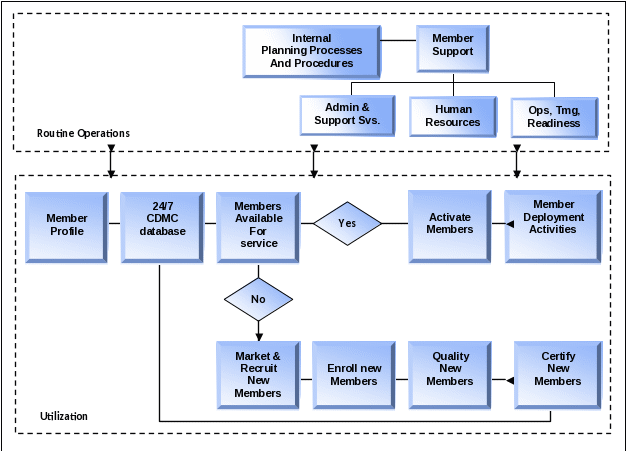
Figure 3.2-1: NLSC Operations
The NLSC accomplishes functional responsibilities in the performance of these operations that include:
Office of the Director: Director, Quality Assurance and AM&R, General Counsel, Legislative Affairs
Office of the Deputy Director: Deputy Director, Public Affairs, Inspector General, Equal Opportunity, Medical Counsel, Finance and Accounting
Plans and Policy: User Agreements and Liaison, Lessons Learned, Requirements, Programming and Budget
Operations: Operations Center, Member Readiness, Certification, Language Proficiency Training, 24/7 CDMC
Human Resources: Member Agreements, Pay and Benefits, HR Support
Marketing
Supply and Services: Facilities, Transportation, Supply, IT Infrastructure, Procurement and Contracting
Security: Information, Physical, and Operational Security; Staff Clearances; Member NACs
Recruiting
The successful performance of these functions enables the NLSC to fulfill its responsibilities for obtaining, preparing, activating and deploying Members that are proficient in language skills; knowledgeable in cultures, including the cultures of other team members; dependable; and an asset to the User.
The remainder of this document describes how the NLSC works with others to develop near-, mid-, and long-term language requirements with emphasis on surge requirements during emergency situations; markets to population sectors with these language skills; recruits, certifies and enrolls Members; prepares these Members for service with training and readiness programs; and, activates, deploys, and redeploys Members for service in support of Users. It also describes support provided by the 24/7 Communications and Data Management Center; the process and template for preparing the NLSC budget; and the organizational structure that supports NLSC operations. The document concludes with a description of the plan for testing and evaluating the Prototype as a prelude to recommending a plan for a fully operational NLSC.
3.2.1Requirements Determination
3.2.1.1Assumptions
The assumptions being used in support of a CONOPS for determining language requirements are provided below.
Since 9-11, the understanding of language as an element of operational capabilities has increased among Government agencies
Government agencies generally have requirements determination processes available to project, prioritize, and fill language support requirements
Processes are not standard; processes and their maturity vary between Government agencies
Government agencies have devised methods for obtaining language support services necessary for meeting operational requirements
Language support services compete with other requirements within a constrained budget
Dependability of language support being provided is a key consideration that is directly related in importance to the criticality of the mission being performed
Government agencies are more likely to support language support services that address problems and that are low cost, low risk, and user friendly
Requirements Determination process for fully operational NLSC is not constrained by the current three year prototype contract
3.2.1.2CONOPS
Figure 3.2.1.2-1 illustrates the process used to determine language requirements for the National Language Service Corps (NLSC). The NLSC, orientated to serve User interests, has a unique perspective within the Federal Government to assist in anticipating and translating national security and domestic needs into quantifiable operational requirements.
Figure 3.2.1.2-1: Requirements Determination
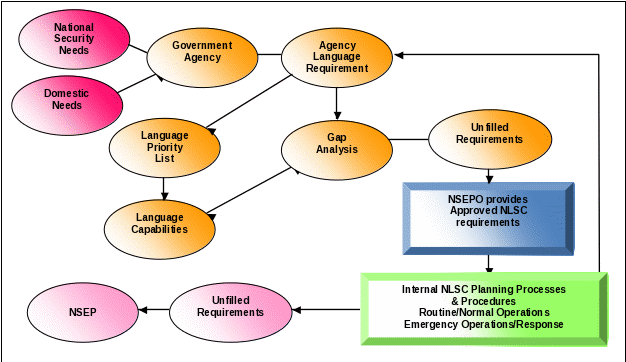
The reality is that not all federal and state agencies use a structured approach such as the ones illustrated above for determining requirements. The National Language Service Corps’ central position as an honest broker focused solely on language capabilities enable it to facilitate and provide assistance across the full community of Users. The Director, National Security Education Program (NSEP) is the Government’s Contracting Officer Technical Representation for the National Language Service Corps and is positioned to facilitate the introduction and maturation of its approach for determining language requirements. The National Language Service Corps is organized to provide staff analysis and planning support to the Director, NSEP in fulfilling the role as facilitator.
The process for determining requirements begins with an assessment of the national security and domestic needs of the nation. Examples of national security needs include language support for American embassies; operations of U.S. military forces; intelligence activities; emergency relief operations in the case of famine, floods, fires, earthquakes; and refugees. Examples of domestic needs include language support for homeland security, immigration, emergency relief operations, and for U.S. residents, including citizens, with limited or no English language proficiency.
While the requirements of immediate national security and domestic needs are often quickly determined, as indicators of events begin to signal an occurrence or even as events unfold, the requirements of future events are usually not well-defined and are, at best, a forecast derived from the analyses of documents such as national strategy, intelligence estimates, and long range studies.
Government agencies (as well as States) analyze and translate national security and domestic needs into operational requirements to establish agency language requirements. These language requirements are compiled in a priority listing of languages to be supported with existing and available language capabilities. There may be instances when a gap analysis reveals that existing and available capabilities do not meet agency language requirements resulting in unfilled requirements. The alternatives for meeting unfilled requirements include changing the requirements to match available capabilities or obtaining additional capabilities.
Unfilled requirements are provided to the National Language Service Corps, a primary source of a readily available civilian corps of language speakers that is able to quickly meet unexpected, surge, and/or emergency requirements. If the language capabilities for current or future requirements are not available in the National Language Service Corps or elsewhere, the Director, NSEP may, as illustrated above, use the National Security Education Program as an established program for addressing the gap.
In its role as a facilitator and informed advisor, the National Language Service Corps will support interagency activities for developing requirements determination. These requirements can be grouped into two general categories:
Current requirements include programs and activities for which Government agencies are responsible and have committed resources at the present time and in the immediate future. These requirements normally can be defined with some accuracy in terms of conditions, responsibilities, timing, actions of subordinate organizations, and locations.
Future requirements are conditional, dependent on uncertain circumstances arising at some point in the future. The National Language Service Corps may encourage federal agencies to further group future requirements as:
General requirements are associated with broad Government agency responsibilities such as responding to natural disasters.
Specific requirements are associated with specific plans such as DoD OPLANs.
Unplanned requirements are associated with subjective assessments of future challenges and a decision to “hedge” against a possible contingency.
Table 3.2.1-2 provides a summary of these requirement categories cross-walked against conditions, responsibilities, timing and actions, and location.
Table 3.2.1-2: Language Requirements categories
Type |
Conditions |
Responsibilities |
Timing & Actions |
Location |
|
|
|
|
|
Current |
Specified |
Defined |
Specified |
Specified |
General – Future |
General |
Defined |
General |
Not Specified |
Specific – Future |
Defined |
Defined |
Specified |
Specified |
Unplanned – Future |
Undefined |
Undefined |
Not Specified |
General |
Requirements determination for the National Language Service Corps is influenced by a number of factors. These factors are described below.
Urgency is the criticality of time for meeting operational language requirements. For exercise purposes, a high urgency requirement is defined as one that must be met in 48 hours or less; a medium urgency requirement must be met in one month or less; and a low urgency requirement can be met in one month or more.
Duration is the length of time language assets are committed to requirement-driven tasks. For exercise purposes, a short-term commitment is a period of time up to one month; a medium-term commitment is a period of time from one to six months; and a long-term commitment is service of over six months.
Scale is defined as the number of Members necessary to fill requirements. For exercise purposes, a limited scale involves less than 20 Members; a small scale is 21 to 100; a medium scale is 101 to 500; and a large requirement is more than 500 Members.
Function is the type of language service being performed. These services may include: translator for the transfer of meaning from one language to another; interrogator to obtain information by direct questioning of persons under conditions controlled by the interrogator; or instructor to provide training in foreign language skills.
The language function is an inherent factor used to define agency language needs. It includes the number of languages and dialects required; the nature of languages and dialects; and the predictability by which languages can be managed at any one time.
The locations for the services being provided include both within the United States and overseas.
Working conditions are defined as the health and physical conditions for performing services and may impact Member willingness to perform language service. The working conditions include normal which is comparable to a modern U.S. city; austere in which the Member is removed from many of the amenities of living and working in a modern U.S. city; and hazardous which include austere conditions, in addition to a potentially personal dangerous situation.
The language source considered is the personnel pools from which prospective applicants are marketed to, recruited, and enrolled into the service of the National Language Service Corps.
In its role as facilitator for developing language requirements across the Federal Government, the National Language Service Corps will ensure the views of the User community are considered and satisfied. In particular, the nature of language requirements varies greatly among federal agencies. Non-DoD agencies often expect language requirements to be associated with a higher urgency (<48 hours) while DoD organizations plan for requirements with 30 days or more notice. Unfortunately, few agencies place stress on the potential need for unexpected language requirements. An estimated 2/3 of federal agencies expect to have requirements for more than a limited (<20) number of Members and ten or more languages, including less commonly spoken languages. Approximately 50% of federal agencies:
Expect language requirements to be predictable and an equal percent expect language requirements to be unpredictable.
Indicate language work would be primarily outside the U.S.
Expect hazardous work conditions to be probable.
A significant number of federal agencies support simple, cost effective solutions that help them accomplish their assigned tasks. There is a preference to “pay for needed services” with little existing support for “investment funding”. A high percentage of federal agencies use some form of contractor support for linguistic specialists.
While a number of government agencies have their own priority list of languages, the lists vary between agencies, as do the procedures for updating these lists. Furthermore, agencies have greater support for high priority languages and less commonly spoken languages and they are concerned that their language requirements receive a high enough priority to be filled. They also insist that NLSC Members are prepared for deployment and working as a member of a Government team; possess the required language skill proficiency; be knowledgeable in cultures, including the cultures of other team members; are dependable and do not constitute a burden. There are a number of situations when security clearances and background checks of NLSC Members are necessary. Additionally, some Government agencies have concerns about the liability of NLSC Members for faulty translation.
Table 3.2.1-3 defines the relationships and interactions with and in support of other NLSC functions and activities.
Table 3.2.1-3: Functional Relationships and Interactions
Function: Requirements |
|
Function/Activities |
Relationships/Interactions/Support |
Director
|
Comply with guidance from the Director.
|
Deputy Director
|
Comply with guidance from the Deputy Director. |
Plans & Policy
|
Provide budgeting requirements/ Use information gathered from lessons learned to adjust marketing efforts and alter media choices/Use gap analysis to identify unfilled requirements. |
Operations
|
Provide Members 24/7 worldwide access and distribution necessary to meet requirements/ Supports the required numbers and locations of Members with educational and training materials/Provides databases required for supporting the Members during both normal and emergency operations. |
Supply & Services
|
Ensure equipment and materials are available/ Provide supplies and telecommunications to enable accomplishment of the mission. |
Security
|
Comply with information technology guidance. |
Human Resources
|
Provide activation and placement criteria for Members. |
Recruiting |
Provide the Members necessary to meet requirements. |
3.2.1.3Metrics
Table 3.2.1.3-1 defines the metrics used to measure and report the effectiveness and acceptance of the NLSC approach for developing the language requirements of federal agencies.
Table 3.2.1.3-1: Metrics Definition
Requirements Determination |
|
Description: Requirement Determination is the process for analyzing and translating national security and domestic needs into operational language requirements, determining the existence of language capabilities and/or gaps for fulfilling these operational requirements, and for filling any resulting gaps. |
|
Goal: An efficient and effective NLSC Requirements Determination approach that is accepted and used by federal and state government agencies for identifying and developing NLSC language requirements in support of national security, |
|
Metric: The National Language Service Corps is able to meet 100% of the language requirements provided to them by the federal agencies. |
|
Measure of Performance |
Data Elements |
Meeting of National Security needs
|
Number of national security needs
|
Meeting of Domestic needs
|
Number of national security needs
|
Participation of Government agencies
|
Number of Government agencies with language requirements
|
Identification of Government agency language requirements
|
Number of language requirements of participating Government agencies
|
Development of language priority lists
|
Number of participating Government agencies with language requirements
|
Presence of Language capabilities
|
Number of language capabilities on the priority lists
|
Conduction of gap analyses
|
Number of participating Government agencies with language requirements
|
Determination of unfilled requirements |
Number of participating Government agencies with language requirements
|
Unfilled requirements consigned to the NLSC |
Number of unfilled requirements
|
3.2.2Marketing
3.2.2.1Assumptions
The NLSC attracts prospective applicants through external marketing efforts including advertising and relationship-building. The assumptions supporting the NLSC Marketing CONOPS are provided below:
Marketing’s strategic messaging penetrates desired markets and appeals to populations with a propensity to volunteer
Marketing supports the phase prior to the recruiting effort and does not focus on building awareness or shaping the perception of the NLSC among Users, legislative bodies, or the general population
There is a single marketing program directed at both the Dedicated Sponsor and National Pools
The NLSC is classified as a civilian service corps
Marketing identifies the NLSC as a public service program that “adds meaning and purpose to one’s language skills” and that “strengthens global unity”
Marketing anticipates supporting a surge of incoming language requirements
The marketing effort is conducted primarily in English with exceptions if the selected medium has no English language editorial or advertising or if the medium offers a clearly-defined bilingual choice
3.2.2.2CONOPS
The NLSC’s marketing program seeks to capture the spirit of volunteerism by attracting individuals who have a desire to give back to their community. The Member is 18 years or older, a U.S. citizen, proficient in English as well as a desired language with professional status.
The development and distribution of marketing materials will be directly proportional to the media plan. Based on preliminary expectations, on-line media is anticipated to be the prime medium to reach out to NLSC prospects. On-line sites will be considered according to their efficacy in reaching out to prospective applicants. Such on-line media includes:
Language-specific news and culture websites
Language and culture-specific social networking sites
Volunteer sites
College networking sites
The NLSC will also utilize:
Language-specific Television Stations and programs
Language-specific Radio Stations and programs
Language-specific newspapers and magazines
College newspapers
Public Service Announcements, if applicable
Direct Marketing (via e-mail and mailing lists)
It is important to note that language-specific media are readily available for a number of languages. Although the NLSC recognizes that prospective applicants among heritage communities, in particular, prefer their first language, it is essential that prospective applicants are proficient in English as well as the desired NLSC language. The NLSC’s on-line marketing campaign is an effective and cost efficient alternative to expensive television advertisements and the less personal approach of radio; however, alternatives will be considered and evaluated.
According to the National Security Education Program, United States Civilian Linguist Reserve Corps Feasibility Study, National Defense University, 2003, 38% of targeted heritage communities are willing to engage in service with a government organization like the NLSC. Therefore, marketing materials developed will deliver strategic messaging for all NLSC prospects. Appropriate messaging enables the NLSC to attract prospective applicants interested in serving their respective communities and contributing to the greater good by using their language skills.
Marketing defines its target according to language requirements as specified by Plans and Policy. As illustrated in Figure 3.2.2-1, Marketing analyzes the language populations according to language speakers in the most densely-populated areas while considering factors that influence their partiality to volunteer.
Figure 3.2.2-1: Marketing
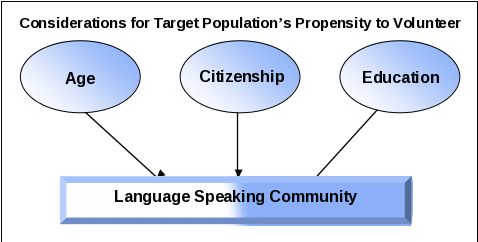
Studies have shown that individuals with higher levels of education also display a higher propensity to volunteer. Thus, a mixture of these factors is considered when defining the target market including the language and the represented communities in the United States. NLSC’s marketing team appeals to the ideal communities and urges them to access the NLSC website, call the toll-free telephone number and/or to contact a recruiting representative.
Marketing is responsible for developing the messaging that appeals to the ideal volunteer. The strategic messaging of the NLSC embodies the benefits available to prospective applicants. For instance, the target volunteer market of the NLSC is attracted by the opportunity to get involved with a governmental agency, take part in cross-cultural communication, and/ or receive benefits such as training, skill enhancement, and support. To the prospective applicants and public, marketing communicates the numerous benefits of the NLSC.
The role of the Marketing staff includes support primarily in researching market segments and language populations; developing marketing materials; and building and evaluating statistical marketing metrics and models for continued use. Marketing will stay abreast of changes in the heritage language communities through information obtained from the U.S. Census Bureau, and anticipate including or expanding its current marketing campaign as appropriate.
Successful marketing is validated by the number of prospective applicants accessing the NLSC’s website, toll-free telephone number, or through personal contact. Ultimately, the goal of the NLSC is to persuade prospective applicants to join the organization, and then as Members, to provide a language skill that meets the User requirements. On a smaller scale, Marketing must measure its successes by evaluating web and other incoming activity, determining whether the public shares the values of the NLSC.
Table 3.2.2-2 defines the relationships and interactions with and in support of other NLSC functions and activities.
Table 3.2.2-2: Functional Relationships and Interactions
Function: Marketing |
|
Function/Activities |
Relationships/Interactions/Support |
Director
|
Comply with guidance from the Director.
|
Deputy Director
|
Comply with guidance from the Deputy Director. |
Plans & Policy
|
Provide budgeting requirements/ Use information gathered from lessons learned to adjust marketing efforts and alter media choices. |
Operations
|
Utilize information provided from the 24/7 CDMC to analyze and adjust marketing efforts. |
Supply & Services
|
Assist in vendor selection for merchandizing and advertisements/Ensure adequate storage facilities available for materials. |
Security
|
Comply with information technology guidance. |
Human Resources
|
|
Recruiting |
Use marketing materials to contact, sale and enroll members in NLSC. |
3.2.2.3Metrics
The marketing metrics being used to ensure the criteria are met are provided in Table 3.2.2.3-1.
Table 3.2.2.3-1: Metrics Definition
Marketing |
|
Description: NLSC marketing spreads the message of the organization in an effort to appeal to prospective applicants and the community through available technology and media sources. |
|
Goal: To attract language speakers who are willing to serve as Members of NLSC. |
|
Metric: The NLSC will assess basic demographic information in order to measure and track the effectiveness of the marketing and advertising campaign, including Web, On-line Media efforts, and lead management. |
|
Measure of Performance |
Data Elements |
Identify the format of Inquiries. |
|
Source of the inquiry |
|
Status |
|
Tracking the prospective applicant |
|
Interest generated from the web and media |
|
Member |
|
3.2.3Recruiting
3.2.3.1Assumptions
The speakers of the desired languages exist among the U.S. citizenry and in large enough numbers to meet the requirements
Users exist in the form of government agencies and organizations that have a demonstrated need and use for the services of the NLSC.
The NLSC’s brand, or marketing, presents the correct image to Members and Users so that it attracts interest and participation.
3.2.3.2CONOPS
The major objective of Recruiting is to develop and test a successful methodology for recruiting Members for the NLSC. This methodology includes:
Locating sources of volunteers
Locating sources of Recruiters
Identifying best methods for reaching and recruiting these sources of volunteers
Ascertaining what practices do not work or work poorly so that these practices can be avoided in future hiring
Cataloguing best practices for implementation of the NLSC
Plans & Policy will provide the Recruiting office with the requirements for hiring.
Figure 3.2.3-3 provides a quick overview of how the recruiting process flows from the Plans & Policy office, which works to identify NLSC requirements:
Figure 3.2.3-3: Recruiting Plan
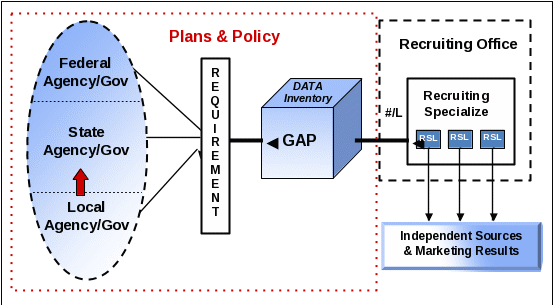
The 24/7 Communications & Data Management Center (CDMC) will capture information on prospective applicants. The database will be integral to Recruiting operations as described below:
Information contained in the database:
The CDMC database has information on prospective applicants which will be used by the Recruiters for screening
The prospects that pass the initial screening will be contacted to determine interest, suitability, and availability. Applicant profiles will also be updated at this time with any current information.
Prospects deemed most suitable will be interviewed.
Information not contained in the database:
If information on suitable Members is not contained in the database, Recruiting will interact with Marketing to develop recruiting materials and interact with the locators to search for suitable prospects.
Once prospects are identified, Recruiting will go through the processes of capturing information and entering it into the database. This capture will take the form of registration, questionnaires, and interviews.
Prospects deemed most suitable will be interviewed.
This process is captured in Figure 3.2.3-4. It demonstrates the importance of the NLSC database once the NLSC is operational; it will become increasingly valuable as the Pilot Program develops and more and more candidates are qualified and added to the database.
Figure 3.2.3-4: Recruiting Plan
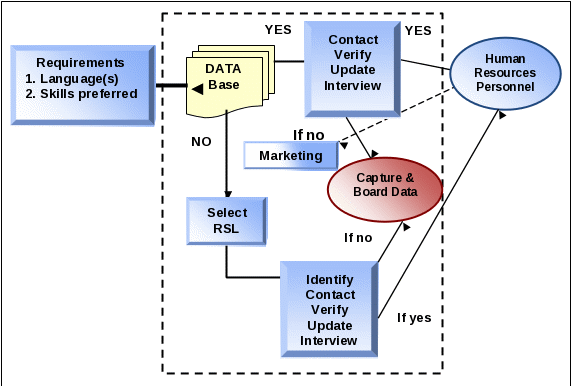
When the database produces potential candidates to meet the requirement, these are forwarded to Human Resources. If it does not produce likely candidates, Recruiting begins the traditional recruitment process. The red area highlights the importance of all contacts, as information on all contacts is maintained and updated periodically in the database for future use.
3.2.3.3Recruiting Criteria
The Recruiting effort of the NLSC will be successful if it:
Anticipates and meets the needs of Users and Members
Works collaboratively with other public and non-profit organizations that can provide mutual benefit to the recruiting process
Is demand responsive – responds to the recruiting needs of the NLSC and its Users quickly, efficiently, and effectively
Makes it easy to be a Member
Makes it easy to be a User
Develops and implements the right type of recruiting infrastructure/systems to satisfy the needs of the User quickly, efficiently, and effectively
Identifies the type of prospective applicant with the right qualifications as well as the right motivation/persona suitable to a service-oriented organization crossing cultures and diverse expectations
Employs the type of recruiting staff that is service-oriented, mission-driven, and entrepreneurial / pioneering to respond to User needs pro-actively
In conjunction with marketing, sells the right image to the prospect
Works with Marketing to establish a volunteer Board of Advisors of persons with prominence and influence within their heritage group(s) who are called upon for advice and direction to ensure fewer faux pas and increased effectiveness in dealing with recruiting / cultural issues
The Assumptions made in Section 3.2.3.1 are correct.
3.2.3.4Staff Responsibilities
Recruiting will collect a great deal of information as it interacts with Users, Members, the HR community, and collaborative organizations. They will have input into the following:
Data elements that will be used in the 24/7 Communications and Data Management Center system
Making it rewarding to become a Member in the NLSC
Developing and maintaining relationships with the Member influencing retention rates
Task # 1
Recruiting sees as its first task the necessity to establish key relationships with possible locators of talent. The Recruiting effort will determine the nature of relationships necessary for establishing the NLSC’s recruiting relationships and requirements for ensuring collaboration with the following:
Academia
Corporate entities (large, medium, small)
Federal Government
Local governments
Non-governmental Organizations (NGOs) (associations, non-profits, charitable, faith-based, secular)
Search firms, agencies (temporary, permanent)
Ethnic communities
Determining the nature of relationships refers to things necessary to put in place in order to maintain these relationships. This could include: retainers, participation in events, offering of events, presentations, etc.
Recruiting relationships with sources of talent will be influenced by various factors. These include, but are not limited to, factors identified in the below schematic in Figure 3.2.3-5:
Figure 3.2.3-5: Factors Influencing the Recruitment Arrangement
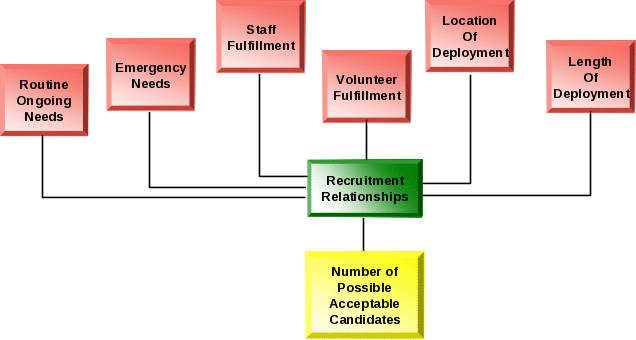
Task # 1 Action Items
Relationships – Recruiting initially must develop the type of relationship with possible sources of candidates that produces information for sourcing or the candidates themselves. Recruiting sees the following action items as necessary to be successful:
Research and establish relationships with all possible entities which might be helpful for the formation and functioning of the NLSC
Research and set up
Identify “pillars” of the ethnic communities who could be helpful
Marketing – Recruiting will work closely with Marketing at the onset of developing and implementing the Pilot Program. This includes developing Recruiting materials and campaigns. Recruiting sees the following action items as necessary to be successful:
Work with Marketing to develop and market search material, brochures, ads, on-line promotions and interest capturing stories, articles, and WebPages.
Work with Marketing to interact with the ethnic communities and to develop the Board of Advisors.
Identify “pillars” of the ethnic communities who could be helpful
Provide feedback to Marketing on successful initiatives, relationships, hires, etc. so Marketing can disseminate that information through their communication channels
Human Resources – Recruiting will work with Human Resources to get feedback on the successes, difficulties, and failures of the Members recruited. This will be important information in order to determine what works and what does not work when identifying the right applicants and satisfying the User’s needs. Recruiting will:
Work with Human Resources to
establish procedures that relate to the choice applicant selection processes
develop needed feedback information on:
successful placements
rejected applicants
applicant rejection of placement
unsuccessful placements
time to place
cost to place
difficulties encountered by both prospects and staff
Additional Item of Importance – In order for Recruiting to do its job, it is important to understand the competition as well as to establish relationships so that they may be a potential source of help. It will be important to understand “business practices” of commercial language service providers and develop relationships with those providers which might be needed for dire circumstances
Task # 2 Action Items
The Task – Input into the choice, modification, and/or development of a searchable database for capturing information related to possible candidates. The data captured will be useful for choosing the “most likely to succeed” applicant that meets the language, cultural, skill, demographic and availability requirements of each particular need and for compiling a comprehensive listing of potential attributes for staff and Members including, but not limited to, the following:
Job qualifications:
Languages --Certified skill in each Language
Dialect differentiation capability
Cultural competence
Professional Expertise / skills / abilities
Training
Work history
Reason given for interest
Professional associations
U.S. Citizenship / Status
Clearances
Personal considerations:
Vacation dates
Employer
Propensity to travel
Hobbies
Family ties
Associations
Need to know – but illegal to ask:
Gender
Religion
Race
Psychiatric assessment
Associations
In order to find out the above, the importance of the personal interview becomes paramount because while not foolproof, many of the “Need to know” items are revealed in the conversation with and behavior of the prospect.
Table 3.2.3-6 below defines the relationships and interactions with, and in support of, other NLSC functions and activities.
Table 3.2.3-6: Functional Relationships and Interactions
Function: Recruiting |
|
Function/Activities |
Relationships/Interactions/Support |
Director
|
Cultivate an internally receptive environment focused on the members that make-up the organization.
|
Deputy Director
|
Comply with the Director’s guidance and focus on the external awareness of the organization. |
Plans & Policy
|
Convey the needs of NLSC Users to appropriate Members via Marketing and Recruiting.
|
Marketing |
Locate, analyze and prepare the target communities for the Recruiting effort. Maintain a close relationship and open communication with Recruiting by relaying analyzed data. |
Operations
|
Utilize information provided from the 24/7 CDMC to analyze and adjust marketing efforts. |
Supply & Services
|
Support through the provision of adequate accommodation for the staff. Ensue materials are provided for the performance of duties and support through the maintenance of necessary IT systems. Ensure Recruiting is able to procure the necessary resources to perform their duties efficiently. |
Security
|
Comply with information technology guidance. |
Human Resources
|
Prepare to receive Recruiting data collected and member applications. |
3.2.3.5Metrics
The recruiting metrics used to ensure the criteria are met are provided in Table 3.2.3.5-1.
Table 3.2.3.5-1: Metrics Definition
Recruiting |
|
Description: The recruiting process will enable the NLSC Recruiting team to track various components of the recruiting process, checking if the assumptions are correct. |
|
Goal: To recruit language speakers who are willing to serve as Members of NLSC. |
|
Metric: The NLSC will recruit to 80% retention or greater by measuring the effectiveness of various recruiting methods and their impact on retention while not sacrificing the Member’s ability to satisfy User requirements. |
|
Measure of Performance |
Data Elements |
Number of responses to advertisement. |
|
Interviews |
|
Tracking Candidates |
Re-engagement
Applicants
|
Member |
|
Incurred Costs |
|
3.2.4Certification
3.2.4.1Assumptions
The assumptions supporting the Certification CONOPS are provided below.
Recruiting:
The NLSC enrolls Members with existing foreign language skills.
Foreign language (and English when required) Assessment and/or Certification ensures a base level of competency and quality for the foundation of the NLSC.
The NLSC will test the language skills of 1000 applicants to the NLSC.
The NLSC will maintain a database of Applicants who have some measurable skill in less-commonly-known languages but who do not meet the minimum requirements during periods other than war or inactivity.
Requirements:
The languages of interest reflect short- and long-term requirements with emphasis on high-level expertise in languages critical to the national security and welfare of the nation.
The NLSC will establish a language certification process involving at least 8 foreign languages during the pilot phase.
The NLSC will seek to obtain language proficiency scores using the Interagency Language Roundtable (ILR) scale.
ILR Level 3 proficiency is the desired foreign language skill level for NLSC Members, however lower levels may also merit enrollment on a case by case basis.
Certification Processes:
The NLSC will establish a four stage certification process.
Applicants with a demonstrated background involving English language are not tested for English proficiency.
The first phase will involve initial screening at application through a global self-assessment of language skills;
The second phase will involve a series of detailed “can-do” self-assessments in the foreign language (and English as necessary) to certify skills for charter membership
Suitability for assessment and certification of NLSC applicants can be sufficiently established during the personnel screening process through a background questionnaire and self-assessment.
The third phase will involve direct testing of foreign language proficiency (and English when required) for certification for activation readiness
The final phase will involve user-agency certification of the language- related aspects of job performance for those NLSC members who are activated
Sufficient foreign language tests exist to certify NLSC Applicants in the languages required as part of NLSC operations.
The NLSC will use existing testing material to assess and/or certify NLSC Applicants in reading, listening, and speaking.
The NLSC will collaborate with governmental and commercial language enterprises to ascertain the necessity of and for developing new testing capabilities.
The NLSC will establish agreements with contractors or existing government agencies for test development or administration, or for use of their tests.
The NLSC will monitor the work of language testing contractors, assuming responsibility for quality assurance.
3.2.4.2CONOPS
The provision and maintenance of a readily-available civilian corps of individuals proficient in one or multiple foreign language(s) is the core of the NLSC’s mission for supporting the national security and welfare of the nation. In order for the NLSC to provide quality service, it must assess and certify the general linguistic competency of its Members. As the primary element of the NLSC’s foundation, foreign language skills are the principal desired asset of NLSC Members. Thus, to facilitate the NLSC’s operational success, membership will be conditional upon the satisfactory assessment and/or certification of an Applicant’s foreign language and English proficiency.
Once an Applicant has submitted his/her application for NLSC membership to HR’s Member Agreements, this staff will construct a record based on the Applicant’s data. The basic information will come from the application which, as a minimum, includes basic citizenship/s, age, selective service registration (if applicable), contact information, and basic language information. Questions will be asked in accordance with legally-defined regulations and practices. Additional information will be obtained from the Applicant based on the background questionnaire, self-assessment, and a NAC or other background check based on potential User requirements. The Applicant’s data records will then be assessed by the staff and scheduled for language certification as necessary and as determined in this CONOPS. Figure 3.2.4.2-1 illustrates the initial screening and certification process for Charter Membership:
Figure 3.2.4.2-1: Certification Workflow for Screening and Membership
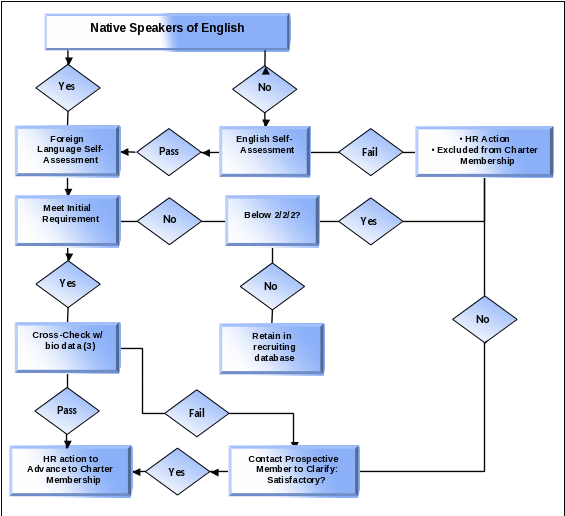
Through the use of a personnel background questionnaire and self-assessment, the preliminary screening process will serve to eliminate unsuitable Applicants from performance testing. The background questionnaire and self-assessment serves as an initial gauge of the Applicant’s ability by taking into account the Applicant’s history, education, and personal evaluation. The background questionnaire will feature prompts to elicit information that includes:
Applicant’s native language
Applicant’s primary language
Applicant’s Foreign language(s)
Where the Applicant uses/d his/her foreign language(s)
Where/How Applicant learned the foreign language(s)
Applicant’s skills in the foreign language(s)
Experience using the foreign language(s)
Prior testing in the foreign language(s)
Applicant’s educational background
Applicant’s professional background
In the self-assessments, NLSC Applicants will rate their ability to handle a variety of language tasks associated with different levels of the ILR proficiency scales.
The initial language screening will consist of a global self-assessment of language skills. Applicants will be provided with a simplified set of ILR skill level descriptions (an example of which is provided in the next figure) and asked to read the description for each skill and select the one that best describes his/her language proficiency in that skill. The selected skill level description will serve to confirm or disconfirm the predicted language skill level obtained from the analysis of the responses to the Can-Do statements. The self-rating on the ILR scale will then be conjoined with the predicted score on the Can-Do scales to produce a predicted language proficiency level. If the Applicant scores level 2 or higher on the predicted language proficiency rating, he/she may undergo formal testing of language skills. Thus, after an analysis of the Applicant’s responses to the background questionnaire and self-assessments of his/her skills in their foreign language(s) and English, it is possible to determine if the Applicant merits actual performance testing and certification of his/her language proficiency.
Additionally, all candidates will be asked for their native language, and will be asked to provide information on their formal education, as part of the initial application. IF the candidate is not a native English speaker, and if the candidate did not graduate from an accredited US high school or institute of higher education, the candidate will be required to self-assess for global proficiency in English as well.
Level 3 proficiency is the requirement desired for NLSC membership, although some variation in this standard may be possible or necessary. For example, in Spanish, where a large number of highly proficient applicants may apply, the minimal standard for membership may be higher than Level 3 proficiency. Conversely, in languages that do not have a writing system or in which very few individuals have literacy, it may be necessary to accept Applicants whose literacy skills are lower. If an Applicant is not admitted to membership, his/her predicted scores and formal language proficiency test scores may be maintained in the NLSC database for future reference.
English Testing: An applicant whose background is indicative of English proficiency – whether through graduation from an English-language institution or program, existing accreditation, etc. – may not require assessment or testing for English aptitude. The CONOPS for assessing the English proficiency among all other NLSC Applicants is via the Internet-based Test of English as a Foreign Language (TOEFL iBT). The TOEFL iBT measures the ability of non-native speakers of English to use and understand English as it is spoken, written, and heard in college and university settings. Internet-based testing is now widely available in all 50 states across the U.S. with numerous testing dates scheduled annually October through December.
The TOEFL iBT is more strongly oriented toward use of English in academic contexts, as opposed to more general English proficiency. Thus, the TOEFL iBT tests some of the higher-level language skills (e.g., the ability to speak intelligibly on abstract topics and to support opinions with consistent argumentation) associated with ILR Level 3. Commercial firms such as Educational Testing Service may be used by the NLSC to provide the testing facilities and verifies the candidate‘s identity.
Furthermore, the TOEFL iBT reports separate scores for each skill (listening, speaking, reading, and writing), but it does not use the ILR scale. Thus, it will be necessary to develop a concordance between the TOEFL scale and the ILR scale. ETS developed such a concordance for the previous paper and pencil TOEFL, however, this test has been largely replaced by the TOEFL iBT. It is reasonable to expect ETS to develop a similar concordance for the TOEFL iBT in the future. However, it will be necessary to request that this be done now so the TOEFL iBT scores can be related to the ILR scale.
Applicants with established English proficiency (previously determined or a score of 3 or higher on the TOEFL) will proceed to the next phase of performance testing.
Foreign Language Testing: The NLSC will seek to test and certify members using tests that correspond to the Interagency Language Roundtable (ILR) scale. The ILR scale is widely-understood by and utilized across the Defense Language Institute (DLI), the Foreign Service Institute (FSI), and other foreign language-related U.S. Government agencies. Table 3.2.4.3-4, shown later in this section, provides the general numerical descriptors and associated abbreviated assessments of the ILR scale.
Foreign language skills testing. To test the candidate’s skills in the non-English language, the NLSC will use tests from multiple sources, including potentially the Defense Language Institute Foreign Language Center and the Defense Language Proficiency Test, as well as tests available from academic and commercial vendors. This approach will include development of criteria for test acceptance, formal bidding as necessary, development of agreements with DLIFLC for test administration, and exploration with DLIFLC of standards and quality assurance oversight for non-USG tests used by the NLSC. The implementation section, below, provides the figures of merit and a model market survey for the foreign language proficiency testing. Figure 3.2.4.2-2, provides the work flow for activation certification.
Figure 3.2.4.2-2: Certification Work Flow for Activation

When encountering a language where no test exists, it will eventually become necessary to develop the capability to administer an OPI in that language. The NLSC will create and sustain a database of foreign language tests that are currently available or being developed. Furthermore, it will establish and maintain collaborative relations with Government and leading commercial language enterprises to remain current on existing services and progress, and potentially cooperate in developing yet non-existent foreign language tests as determined by requirements.
After the Applicant completes the performance testing stage, the official scores are used to certify his/her language proficiency and to determine if he/she should be enrolled as a Member. If a decision is made to enroll, the Member will be advised of such. Regardless of the decision, the Applicant’s scores will be reported to the Applicant and entered into the NLSC database. As a normal business rule, rejected Applicants are not offered the option of retesting.
NLSC Members that do not have native proficiency will be required to undergo recertification of their foreign language skills on a regularly scheduled basis to ensure that their proficiency level has not deteriorated.
This CONOPS recognizes and seeks to address the potential of emergency surge requirements and sporadic volunteerism. Under such circumstances, the NLSC may be required to enroll Members to quickly provide necessary emergency assistance. In these contingency cases, and particularly in those involving on-site volunteerism, self-assessment and spontaneous, limited performance testing may be required. Thus the volunteer will be asked to evaluate their level of proficiency and may undergo a quick oral assessment that may be conducted on-site or via call back to a pre-determined location. The NLSC will notify the User of the Member’s evaluation type and status to facilitate transparency and “truth in lending”.
Table 3.2.4.2-3 defines the relationships and interactions with and in support of other NLSC functions and activities.
Table 3.2.4.2-3: Functional Relationships and Interactions
Function: Certification |
|
Function/Activities |
Relationships/Interactions/Support |
Director
|
Comply with guidance from the Director.
|
Deputy Director
|
Comply with guidance from the Deputy Director. |
Plans & Policy
|
Provide budgeting requirements. |
Marketing |
Develop materials to attract Prospective Applicants with existing language skills. |
Operations
|
Provide a list of Members requiring certification/ Offer Commercial off-the-shelf language training to sustain skills/ Provide electronic notification to Members requiring certification. |
Supply & Services
|
Locate facilities to serve as testing sites/ Initiate contract agreement for proctoring and administration of the test/ Arrange transportation as required. |
Security
|
Comply with information technology guidance. |
Human Resources
|
Ensure Member records are updated with current test results. |
Recruiting |
Enroll Members with existing language skills. |
3.2.4.3Metrics
Table 3.2.4.3-1 provides the Certification metrics.
Table 3.2.4.3-1: Metrics Definition
NLSC Certification Metrics |
|
Description: NLSC Certification assesses and certifies the quality of language proficiency necessary for the NLSC to accomplish its mission in meeting demands of security and welfare of the nation. |
|
Goal: An efficient, effective, and economical assessment and certification process. |
|
Metric: Success is indicated when a match exists between self-assessments/can-do statements and alternative proficiency tests. Success is confirmed when 95% of activated NLSC members are certified as job-ready by User agencies. |
|
Measure of Performance |
Data Elements |
Member Application, Testing and Enrollment |
Initial Screening
English Proficiency Testing
Foreign Language Proficiency Testing
Member Requirements
|
Time
|
Time required for:
|
Cost/Benefit
|
Background Questionnaire, Self-Assessments, & Analysis
Degree to which predicted scores
Cost of administering
|
User Satisfaction |
English proficiency of NLSC Members
Foreign Language Proficiency
|
Recertification |
Number of members
|
Rapid assessment and certification |
Number of rapid assessments
Time required to:
User satisfaction
Comparison of language proficiency level scores obtained via rapid assessment and certification process vice scores determined during full procedure certification score. Number of scores that:
|
Table 3.2.4.3-4 defines the standard skill-level scale established by the International Language Roundtable (ILR) and used by the NLSC.
Table 3.2.4.3-4: ILR Scale
|
Listening |
Reading |
Speaking |
0 No Proficiency |
No practical understanding of the spoken language. Understanding is limited to occasional isolated words with essentially no ability to comprehend communication. |
No practical ability to read the language. Consistently misunderstands or cannot comprehend at all. |
Unable to function in the spoken language. Oral production is limited to occasional isolated words. |
0+ Memorized Proficiency |
Sufficient comprehension to understand a number of memorized utterances in areas of immediate needs. |
Can recognize all the letters in the printed version of an alphabetic system and high-frequency elements of a syllabary or a character system. |
Able to satisfy immediate needs using rehearsed utterances. Shows little real autonomy of expression, flexibility or spontaneity. |
1 Elementary Proficiency |
Sufficient comprehension to understand utterances about basic survival needs and minimum courtesy and travel requirements in areas of immediate need or on very familiar topics, can understand simple questions and answers, simple statements and very simple face-to-face conversations in a standard dialect. |
Sufficient comprehension to read very simple connected written material in a form equivalent to usual printing or typescript. |
Able to satisfy minimum courtesy requirements and maintain very simple face-to-face conversations on familiar topics. |
1+ Elementary Proficiency Plus |
Sufficient comprehension to understand short conversations about all survival needs and limited social demands. Developing flexibility evident in understanding a range of circumstances beyond immediate survival needs. |
Sufficient comprehension to understand simple discourse in printed form for informative social purposes. |
Can initiate and maintain predictable face-to-face conversations and satisfy limited social demands. He/she may, however, have little understanding of the social conventions of conversation. |
2 Limited Working Proficiency |
Sufficient comprehension to understand conversations on routine social demands and limited job requirements. |
Sufficient comprehension to read simple, authentic written material in a form equivalent to usual printing or typescript on subjects within a familiar context. |
Able to satisfy routine social demands and limited work requirements. Can handle routine work-related interactions that are limited in scope. |
2+ Limited Working Proficiency Plus |
Sufficient comprehension to understand most routine social demands and most conversations on work requirements as well as some discussions on concrete topics related to particular interests and special fields of competence. |
Sufficient comprehension to understand most factual material in non-technical prose as well as some discussions on concrete topics related to special professional interests. |
Able to satisfy most work requirements with language usage that is often, but not always, acceptable and effective. The individual shows considerable ability to communicate effectively on topics relating to particular interests and special fields of competence. |
3 General Professional Proficiency |
Able to understand the essentials of all speech in a standard dialect including technical discussions within a special field. |
Able to read within a normal range of speed and with almost complete comprehension a variety of authentic prose material on unfamiliar subjects. |
Able to speak the language with sufficient structural accuracy and vocabulary to participate effectively in most formal and informal conversations in practical, social and professional topics. |
3+ General Professional Proficiency Plus |
Comprehends most of the content and intent of a variety of forms and styles of speech pertinent to professional needs, as well as general topics and social conversation. |
Can comprehend a variety of styles and forms pertinent to professional needs. Rarely misinterprets such texts or rarely experiences difficulty relating ideas or making inferences. |
Is often able to use the language to satisfy professional needs in a wide range of sophisticated and demanding tasks.
|
4 Advanced Professional Proficiency |
Able to understand all forms and styles of speech pertinent to professional needs. Able to understand fully all speech with extensive and precise vocabulary, subtleties and nuances in all standard dialects on any subject relevant to professional needs within the range of his/her experience. |
Able to read fluently and accurately all styles and forms of the language pertinent to professional needs. The individual's experience with the written language is extensive enough that he/she is able to relate inferences in the text to real-world knowledge and understand almost all sociolinguistic and cultural references. |
Able to use the language fluently and accurately on all levels normally pertinent to professional needs. The individual's language usage and ability to function are fully successful. |
4+ Advanced Professional Proficiency Plus |
Increased ability to understand extremely difficult and abstract speech as well as ability to understand all forms and styles of speech pertinent to professional needs, including social conversations. |
Nearly native ability to read and understand extremely difficult or abstract prose, a very wide variety of vocabulary, idioms, colloquialisms and slang. Strong sensitivity to and understanding of sociolinguistic and cultural references. |
Speaking proficiency is regularly superior in all respects, usually equivalent to that of a well educated, highly articulate native speaker. Language ability does not impede the performance of any language-use task. |
5 Functionally Native Proficiency |
Comprehension equivalent to that of the well-educated native listener. |
Reading proficiency is functionally equivalent to that of the well-educated native reader. Can read extremely difficult and abstract prose; for example, general legal and technical as well as highly colloquial writings. |
Speaking proficiency is functionally equivalent to that of a highly articulate well-educated native speaker and reflects the cultural standards of the country where the language is natively spoken. |
3.2.5Human Resources, Activation, and Placement
3.2.5.1Assumptions
The assumptions used in support of a CONOPS for NLSC Human Resources support are provided below.
Human Resources in its entirety is the art and science of providing the right person at the right time for the right mission whether the mission is to fill a staff requirement or to meet a User requirement. For the purposes of this CONOPS, only Human Resources support relating to NLSC Members and Users is addressed. Human Resources support relating to NLSC staff will be covered separately as this could be either an in-house or outsourced function.
Authority to appoint, classify, and compensate NLSC Members will be vested in the Director, NLSC.
NLSC Members will have USERRA or USERRA-like protections.
Scope of Human Resources support encompasses:
Member Agreements: Accessions & Recruitment, Records & Reports, Data Analysis; Placement; Activation;
Pay and Benefits: Management of Member Salaries, Compensation, and Benefits;
HR Support: Issue Resolution; Member Maintenance encompassing Family Support and Casualty Assistance; Deployment/Redeployment Support
Recruiting will also fall under HR however, it will be addressed in a separate CONOPS
Appropriate staff will be available to perform the workload and will be properly trained
Staff will be collocated to facilitate cross-functional utilization.
Function of 24/7 Communications and Data Management Center (CDMC) will be defined and the database structures and search engines will be available to support Human Resources requirements.
Application, Member Data, and Requester Data Sheets will be available.
Marketing and recruiting methods will send interested parties to accessions.
Requisition methods will be finalized.
Lexicon will be established to ensure consistency. It will include definition of terms such as:
Prospect, Applicant, Charter Member, Provisional Member, Member, Position Candidate, Position Designee, Volunteer, Dedicated Sponsor, User, Employer, Agency, Affiliate, Billet, Position, Requirement, Requisition, etc.
Activation requirements will be established to include NLSC Member, User, and Member’s Employer’s rights and responsibilities.
Specific employment status of Members will be established to include applicable compensation and benefits.
Figure 3.2.5.1-1 illustrates the prototype NLSC Human Resources structure:
Figure 3.2.5.1-1: Functional Responsibilities
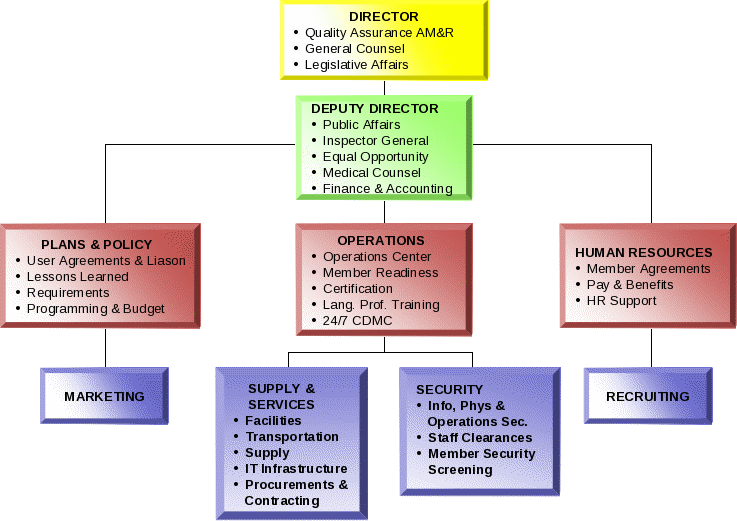
3.2.5.2CONOPS
The NLSC will provide service to two distinct types of “customers.” The first will be those individuals who wish to join and subsequently become Members of the NLSC. The second will be to those organizations or agencies who wish to use NLSC Member language skills. For ease of understanding, all individuals accepted for membership will be called Members. However, for discussion purposes, Members may be identified as belonging to either the National or Dedicated Sponsor Pools. By definition, the National Pool will contain all individuals accepted for membership. It will also contain a subset, identified as the Dedicated Sponsor Pool that consists of Members whose service is sponsored through a specific User Agency.
The process of Human Resources support will begin with a request from one of the two types of customers. These requests may come through the NLSC website, telephone, email, or any other method available to the requester. Regardless of the method, initial contact will be with the 24/7 CDMC. Customer support personnel will then direct the request to the appropriate function.
If the request is via the NLSC website, instructions within the website will provide appropriate direction. The NLSC anticipates that the website will be the primary entry way into the system, and thus many requests will be filed and responded to using electronic means. However, Human Resources Support will not be constrained to electronic means; rather, support will be provided to both customer categories via the most effective method based on the assistance required. As an example, an Ombudsman will be available to all customers to help them with details that might not be clear on the web, or who simply will provide a human face to the NLSC. Figure 3.2.5.2-1 provides a visual description of how this process will work.
Figure 3.2.5.2-1: Support Interface
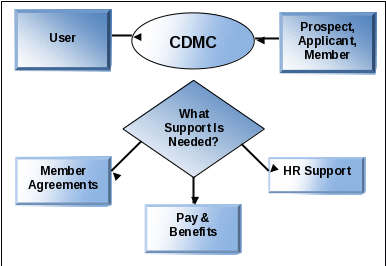
Figure 3.2.5.2-2 provides greater definition of the Human Resources administration model.
Figure 3.2.5.2-2: Personnel/Human Resources Model
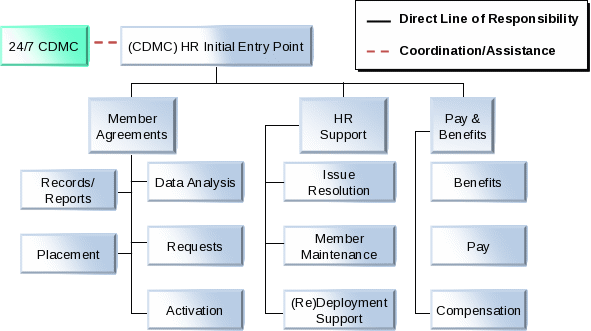
As illustrated, there are a number of functions that will reside in the realm of Human Resources Member and User Support. What will not be handled within this Human Resources structure will be Agreements with the User, Finance & Accounting, Member Readiness, Certification, Transportation, Member NACs, etc. These functions are the responsibility of the Office of the Deputy Director, Plans & Policy, or Operations. Human Resources will, however, input and mine data from appropriate databases, function as a mediator between the User and Member, and facilitate the receipt and utilization of Member Pay, Compensation, and Benefits.
The systems required to facilitate the support actions in the Human Resources Organization Model given above are anticipated to be provided by Commercial Off–The-Shelf products. The task for the NLSC will be to determine the appropriate systems to be used in support of the NLSC’s specific requirements. The approach includes existing systems being employed based upon the best practices from both government and contractor sources.
Regardless of the systems used, the process within Human Resources will remain the same. For the purposes of this CONOPS, each area of Human Resources Support will be discussed individually. The major areas to be covered will be Member Agreements, Pay and Benefits, and HR Support. Within those categories, support and interface with User organizations and agencies will be discussed.
Member Agreements
For the National Language Service Corps to be successful, the Recruiting and Accessions process must be successful. Of course both functions must be in sync with the Marketing function of the NLSC as well. While there is evidence that individuals desiring membership in the NLSC exist and will come to the NLSC once it is operational, there are still many valuable individuals who must be reached. This is where Marketing, Public Affairs, and Recruiting are key factors. Marketing is currently envisioned as a sub-function of Plans and Policy; Public Affairs is in the Office of the Deputy Director. Recruiting will be placed within Human Resources due to the need for close interface with the Accessions function. The specifics of the Recruiting function will be addressed in a separate section due to the complexity of the function. Suffice it to say for the purposes here that Recruiters will direct Prospects to the NLSC’s website or the 24/7 CDMC as appropriate.
Through electronic means and personal interface Prospects will be provided with all of the information available to assist them in making a decision as to whether they should or should not apply for membership in the NLSC. During this time, the NLSC will capture some personal and contact data on each Prospect for data analysis purposes as well as to build a Standby List for future contact. Once a Prospect decides to apply, he/she will be referred to as an Applicant. The individual will remain an Applicant on the Standby List until he/she successfully completes all membership requirements. If the Applicant does not meet all of the requirements, he/she may remain on the Standby List. The minimum requirements for membership in the NLSC currently include being a U.S. citizen, having reached one’s 18th birthday, passing a national agency check or other background check, achieving the minimum language proficiency level for both English and one or more foreign languages, and, if male, having registered with the Selective Service.
In anticipation of an Applicant’s acceptance for membership, a data record on the Applicant will begin to be constructed. The basic information will come from the Applicant’s application which, as a minimum, will contain basic citizenship/s, age, selective service registration, contact, and language information. Questions will be asked in accordance with legally-defined regulations and practices. If minimum requirements are met, the applicant will be accepted into Provisional Membership. Additional information will then be obtained from the Applicant based on the NAC or other background check application requirements. The Applicant will be scheduled for language certification as necessary. If these additional areas for membership are met, the Provisional Member will be accepted as a full Member and will be placed into the National Pool. Additional information required at this time, in order to facilitate appropriate placement, will include the Member’s desired preference relative to becoming a Member of the Dedicated Pool. This process results in three separate opportunities to obtain information from the Applicant. One final opportunity will exist when a NLSC staff member meets face-to-face with the Applicant/Member. The exact timing of this meeting and the full scope of the meeting are yet to be finalized.
Should the new Member, or an existing Member, desire to join the Dedicated Pool, Human Resources will work to make that happen. This undertaking will be an iterative process involving User requirements, Member qualifications, User and Member desires, etc. The process is facilitated by well-defined requirements and an accurate database. The final match will occur when the User and Member come to terms and finalize their agreement. The form of this agreement will be covered under the CONOPS for Contracts and Compensation.
Figure 3.2.5.2-3 illustrates the Accession process.
Figure 3.2.5.2-3: Accession/Placement Plan
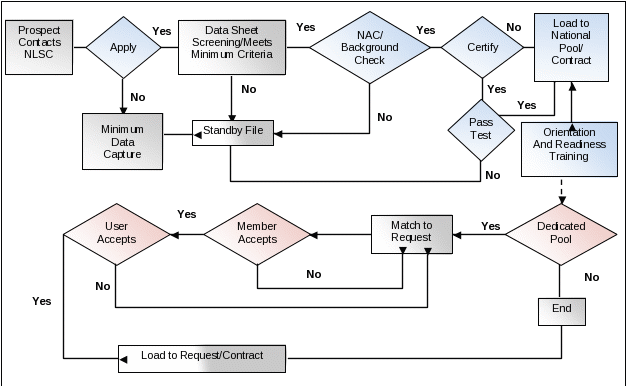
Figures 3.2.5.2-4 to 3.2.5.2-6 break this process into three separate, more clearly-defined steps.
Figure 3.2.5.2-4: Phase 1 of Application Process
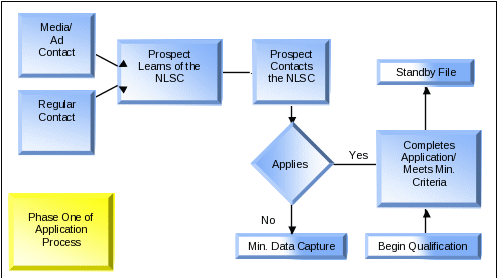
Figure 3.2.5.2-4 illustrates the accessions process from the time a Prospect first learns of the NLSC’s existence, through applying and meeting of the minimum qualification requirements of the NLSC to the point of beginning the final qualification process. If accepted at this point, the applicant will be offered Provisional Membership.
Figure 3.2.5.2-5: Phase 2 of Application Process
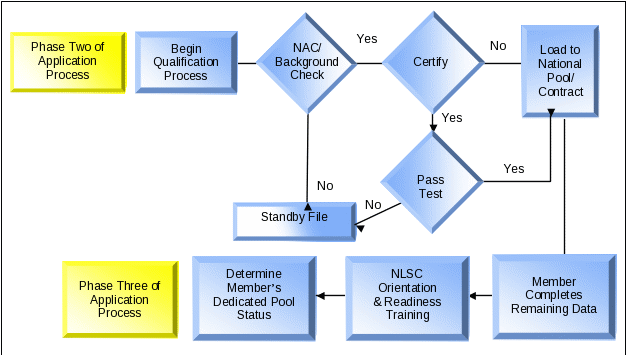
As illustrated in the qualification process, each Provisional Member must now successfully pass the NAC or other designated background review and be certified in both English and a Foreign Language at an acceptable level, as determined by NLSC. Once these actions are completed, the Provisional Member is fully accepted to membership and placed in the National Pool. Any remaining Member data is captured and the Member is scheduled for NLSC Orientation and Readiness Training.
Figure 3.2.5.2-6: Accession to Dedicated Pool
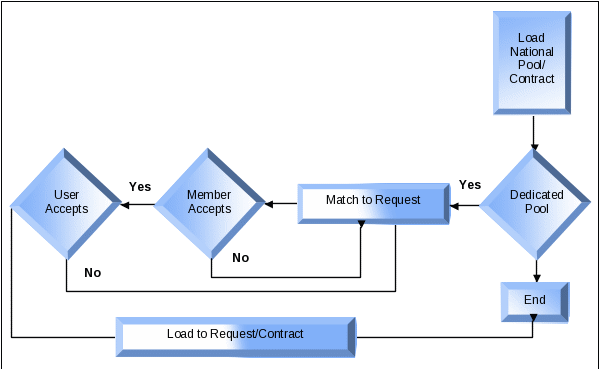
As illustrated above in Figure 3.2.5.2-6, if a Member is interested in becoming dedicated to a Sponsoring User, the NLSC will endeavor to identify an appropriate match.
Now that the Prospect has become an Applicant and subsequently a Member, other functions support and compliment Accessions and Recruiting. The first supporting function is the Data Analysis function. Here, data will be captured on all individuals who express an interest in the NLSC. The amount of data collected and the frequency of access/audit of this information is dependent on the status and classification of the individual (i.e. Prospect, Applicant, Member, Standby List, etc.). Periodic audits of the data will be accomplished in order to maintain data accuracy. Additionally, the data collected will be analyzed in order to aid the Marketing and Recruiting efforts.
Integrally linked to the Data Analysis Function is the Records and Reports Function. Here the individual data collected will be organized into Member records for ease of retrieval and access. These records will then be used with other available data, to provide the internal and external reports required of all organizations. In addition to the standard record maintained on each Member, a Deployed record will be produced for ease of support when a Member is in an Activated/Deployed status. When the Member returns from Activation/Deployment, this record will be removed from the Deployed database.
HR Support
HR Support’s primary function is to ensure the appropriate use of each Member’s language and professional skills and to provide support during Activation, Deployment, and Redeployment. Members will be located in and come from one of the two Member pools. The first is the National Pool to which all Members belong. As stated, these Members have certified language skills that may be used to meet emergent requests. Members in the Dedicated Pool (a subset of the National Pool) have agreed to support a specific User or Dedicated Sponsor. In addition to their certified language skills, these Members may also be using personally-acquired professional skills in support of the Dedicated User’s mission. To accomplish the task of appropriately placing NLSC Members, a clear understanding of User requests is needed.
NLSC anticipates that in the case of a Dedicated Sponsor User, the request will be thoughtfully defined to meet a recurring need. Not only will these requests include a specific language need, it is also likely they will contain the desire for a specific professional skill set. Conversely, there may be no specific professional skill required upon initial placement because the User wishes to train a Member in a specific skill set. In either case, the request needs to be well-defined to include tasks to be performed, language and proficiency level required, number of days to be activated, training provided by the User, payment, etc.
The NLSC anticipates filling Emergent Requests primarily using National Pool Members. Consequently, it is essential that NLSC staff be able to quickly assist the User in clarifying the need; specifically, what are absolutely necessary versus desired, but unnecessary, portions of the request. Accuracy in the defining process will impact the NLSC’s ability to quickly mine the record data for locating Members to fill the request. The list of these Members, now called Position Candidates, will be reviewed to identify the best matches. These matches will then be placed against the request.
The ultimate goal of the Placement Process is to activate NLSC Members to meet national, state, and local needs. The process for Activation of National Pool (Member Activation Diagram) consists of multiple steps as Figure 3.2.5.2-7 illustrates. A review of the start of the process shows that careful refining of the User request is critical to keeping the timeline to a minimum by ensuring quality data matches from the beginning. Since the NLSC is a voluntary organization, it is critical to ensure that Members being considered as Candidates for a position against a request have the opportunity to decline the placement.
Figure 3.2.5.2-7: National Pool Activation

In cases where the request is caused by a planned activity, the User will be provided a list of Position Candidates and will have the opportunity to select from the list. In the case of an emergency requirement, the User may need to accept the Candidates selected by the NLSC (e.g. the portion of the flow chart within the red dotted lines will be by-passed). The NLSC will notify each Candidate of their placement and, for those being activated, will provide orders and reporting instructions.
For Dedicated Pool Members, illustrated in Figure 3.2.5.2-8 below, activation within the terms of their agreement with the User will be a streamlined process. The Sponsor will notify the NLSC of activation and deactivation information. The NLSC will notify the Member and provide the activation orders. Activation outside of the agreement would need to be negotiated with the Member and the NLSC. The Sponsor may release their Dedicated Member to fill a request outside of their organization.
In any of the below situations there are a variety of readiness and activation actions that need to be accomplished.
Figure 3.2.5.2-8: Dedicated Pool Activation
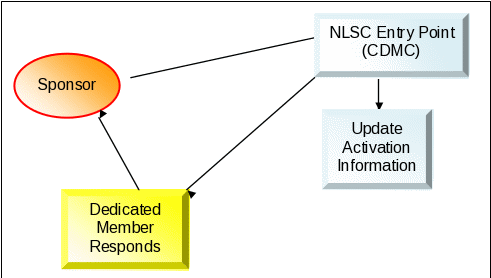
Table 3.2.5.2-9 is a delineation of requirements and responsibilities. Those in Blue may be required dependent on the activation. Red “X’s” denote who pays.
Table 3.2.5.2-9: Requirements and Responsibilities
|
Task |
Responsible Entity |
||
|
|
NLSC |
Member |
User |
1 |
Background Investigation |
X |
X |
|
2 |
NAC |
X |
X |
|
3 |
NACI |
X |
X |
|
4 |
Certification |
X |
X |
|
5 |
Define Requirement |
X |
|
X |
6 |
DD Form 2365-Emergency Essential Agreement |
X |
X |
|
7 |
OSD Letter – Tracking Deployed Civilians |
X |
|
|
8 |
HR Advisory DPIEC 2007-3; Documenting Civilian Deployments |
X |
X |
|
9 |
DD Form 93 Emergency Data |
X |
X |
|
10 |
Shots |
X |
X |
X |
11 |
SF Form 78 Medical Exam |
X |
X |
X |
12 |
Pre-Deployment Health Assessment |
X |
X |
X |
13 |
DD Form 2897-1 Report of Medical History |
X |
X |
|
14 |
DD Form 2813 Dental Exam |
X |
X |
|
15 |
User’s Equipment List |
|
X |
X |
16 |
Passport |
X |
X |
|
17 |
Sample Letter of Authorization – Pay cap Waiver |
X |
X |
|
18 |
AF Form 428 – Pre-approve overtime |
X |
X |
|
19 |
SF Form 1190 – Required in order to process HDP and Special Pay |
X |
X |
X |
20 |
User-specified Training Training Army CRC, Indoctrination Training |
|
X |
X |
21 |
Deployment orders |
X |
|
|
22 |
Transportation |
X |
|
X |
23 |
Medical care, billeting, transportation, messing, and logistical support during the activation (Note 1) |
X |
|
X |
24 |
Tracking Deployed Member |
X |
|
X |
25 |
PL109-234 Benefits, Allowances and Gratuities |
X |
X |
|
26 |
Responsible for Member from front door to front door |
|
X |
X |
Note 1: The NLSC pays for transportation to and from CONUS employment sites and five days of wages and per diem. User pays wages and per diem from day six to end of deployment and any travel required during period of deployment.
The bottom line on the utilization of Members is that they must be prepared, properly utilized, cared for during periods of activation, deployment, and following deactivation, and the family must be kept in the loop. Although the Operations Center will be the point of contact for Activated and Deployed Members, Human Resources retains responsibility for all matters concerning HR Support and will be contacted by the Operations Center staff accordingly.
Another element of HR Support is Member Maintenance, which addresses the desire for Members to feel they are part of something through interactions and information designed to keep Members informed of activities within the NLSC as well as report on assistance that NLSC Members have provided. The potential exists for organized gatherings for Members, regional activities, etc. In addition, the maintenance function includes grievances between the Member and the User as well as between the Member and his/her employer. The function also provides assistance to the Member’s family during periods of activations and deployments and, should an injury or casualty occur, provides assistance to the Member and/or their family. Following post-deployment and deactivation, this function will also provide post-activation follow-up to ensure the Member has the assistance needed.
Pay and Benefits
The major function of Pay and Benefits includes Compensation/Benefits and Member Pay. For the purposes of this discussion, it is assumed that NLSC Members are classified as Excepted Service Employees within the Federal Employee system. As such, they are expected to work on an intermittent basis during the period of their employment.
Once the determination of the category of employee is finalized, and authority to appoint, compensate, and classify is granted, the compensation and benefit (C&B) packages available for the employees will be put into place. Despite the absence of that information, the process for supporting the Member is the same. NLSC staff will assist the Members in applying for and utilizing their C&B packages. Some of the benefits that focus group participants expressed interest in are access to language sustainment and improvement training, trips to the country of their language, opportunities to meet others in their language group, opportunities to help others, retirement benefits, and accelerated citizenship.
As NLSC transitions from a Pilot Program to a fully functional organization, the operating procedures for each of the functions mentioned within this CONOPS will mature as well. The metric provided below will assist in refining Human Resources Support.
Table 3.2.5.2-10 defines the relationships and interactions with and in support of other NLSC functions and activities.
Table 3.2.5.2-10: Functional Relationships and Interactions
Function: Human Resources |
|
Function/Activities |
Relationships/Interactions/Support |
Director
|
Request information and data as part of its efforts to ensure the efficient operation of the NLSC organization/Support and assist in cases where there are allegations of impropriety in hiring practices/Inform HR of any legislative changes that could impact the hiring of NLSC Members or Staff. |
Deputy Director
|
Request further information in cases where fraud or waste or abuse of resources is suspected/Strive to ensure full compliance with laws regarding equal employment opportunities/Teach and guide in best practices regarding the relationship between medical practices and NLSC policies and procedures/Provide direction, planning and oversight for financial policies and procedures. |
Plans & Policy
|
Convey to the needs of NLSC Users to appropriate Members in a fashion that is most beneficial to all interested parties.
|
Marketing |
Support to fill personnel deficiencies through marketing campaigns and efforts. |
Operations
|
Track and support all activated and deployed NLSC Members to be certain they have all necessary equipment to fulfill User expectations/ Conduct and monitor User culture training, operational training, and to ensure deployment preparedness/ Support by ascertaining the foreign and English language skills of new Members, recertifying existing Members, and maintaining records of available tests by language/ Support helping to sustain language proficiency for existing NLSC Members through materials, dialogue, and exchange/ Support by housing the Member database. |
Supply & Services
|
Support through the provision of adequate accommodation for Staff/ Ensure required materials are provided for the performance of duties/ Support through the maintenance of necessary IT systems/ Ensure HR Staff are able to procure the necessary resources to perform their duties efficiently. |
Security
|
Ensure a safe and secured operating environment/ Assist in efforts to obtain the required security clearances/ Assist in efforts to ensure all Members are subject to a possible background investigation (BI), NAC , or NACI background check. |
Recruiting |
Be responsive to efforts to obtain individuals who possess the language skills deemed most critical by the Users. Campaigns and efforts will become focused and fine-tuned based on this information. |
3.2.5.3Metrics
Table 3.2.5.3-1 defines metrics used to measure and report the effectiveness and efficiency of Human Resources Support provided to Members and Users.
Table 3.2.5.3-1: Metrics Definition
Human Resources Determination |
|
Description: Human Resources in its entirety is the art and science of providing the right person at the right time for the right mission whether the mission is to fill a staff requirement or to meet a User request. |
|
Goal: Assess and Place qualified individuals as Members of the NLSC. Provide needed support to those Members to ensure their preparedness for activation. Provide those Members on an “as needed” basis to aid local, state, and federal agencies in time of crisis, national emergencies, or for National Security purposes. |
|
Metric: The National Language Service Corps provides efficient and effective Human Resources support for Members and Users measured by customer feedback – satisfaction of 95% or greater. |
|
Measure of Performance |
Data Elements |
Effectiveness/Efficiency of Recruiting/Accessions Process
|
Methodology: Data capture and analysis for first six months. Success would be: 1) an increase in number of hits over first six month rate; 2) an increase in percent accepted for membership over first six months 3) Decrease in lapse time for each phase. |
Effectiveness/Efficiency of Placement Process
|
Methodology: Data capture and analysis for first six months. Success: 1) Decrease in time from receipt of Request to time of placement; 2) Decrease in number of declinations. |
Effectiveness/Efficiency of Activation/Deployment (These metrics must work with those of the Deployments CONOPS)
|
Methodology: Data capture and analysis for first six months. Success: 1) Decrease time from notice to activate to Member’s arrival at User’s designated location; 2) Increase readiness of Members to activate |
Efficient support for Members Needs
|
Methodology: Data capture and analysis for first six months. Success: 1) Increase percent of initial responses within 24 hours for urgent query and 72 hours for routine queries; 2) Decrease number of NLSC controllable reasons for User/Member grievances; 3) Decrease number of errors in Member records.
|
3.2.6Training and Readiness
3.2.6.1Assumptions
The assumptions supporting the CONOPS for training and readiness are provided below:
The National Language Service Corps (NLSC) enrolls Members with existing language and cultural skills
National Pool Members provide services centered on the use of language skills
Dedicated Sponsor Pool Members perform jobs that include language skills
NLSC Member readiness includes individual, team, and User organization culture training
Particularly for Language Proficiency Training, the NLSC uses existing education and training technology, materials, and methodologies and will not, as a general business practice, develop education and training technologies or materials
NLSC Members are capable of using web-based materials and technologies for education and training
NLSC education and training information and materials will be delivered on-demand 24/7, worldwide to the individual Member’s location
3.2.6.2CONOPS
Figure 3.2.6.2-1 illustrates the population sectors to which the NLSC provides information and training. These sectors include the NLSC User community; NLSC staff and support members, including recruiters; and Members in both the National and Dedicated Sponsor Pools.
Figure 3.2.6.2-1: Populations Requiring Information/Training

Table 3.2.6.2-2 further illustrates the NLSC-provided information and training to each of these sectors by subject areas. As illustrated, the NLSC provides information only regarding language skills, cultural skills, and certification to the User Community, NLSC staff and recruiters, and NLSC Members. The NLSC enrolls Members with existing language and cultural skills and only provides information and materials for the maintenance of these skills. The NLSC also performs assessment testing and certifies the language proficiency levels of Member language skills. NLSC Members may use NLSC-provided information and materials to increase their language and cultural skills to a higher proficiency level; however, the NLSC does not provide formal training for increasing the language proficiency skills of its Members.
Table 3.2.6.2-2: NLSC Training Delivered and Information Provided
Subject Area |
User Community |
NLSC |
National Pool |
Dedicated Pool |
|
|
|
Staff |
Recruiters |
|
|
Language Skills |
nlsc |
nlsc |
nlsc |
nlsc |
nlsc |
Cultural Skills |
nlsc |
nlsc |
nlsc |
nlsc |
nlsc |
Certification |
nlsc |
nlsc |
nlsc |
nlsc |
nlsc |
Job Skills |
|
NLSC |
nlsc |
nlsc |
Dedicated Sponsor |
Member Readiness |
nlsc |
nlsc |
nlsc |
NLSC |
NLSC |
Art of using Language Skills |
|
|
|
|
|
Interpreter |
nlsc |
nlsc |
|
nlsc |
nlsc |
Translator |
nlsc |
nlsc |
|
nlsc |
nlsc |
Instructor |
nlsc |
nlsc |
|
nlsc |
nlsc |
Career Development |
|
|
|
|
|
NLSC functions & processes |
nlsc |
NLSC |
NLSC |
nlsc |
nlsc |
Other Foreign Languages |
nlsc |
nlsc |
nlsc |
nlsc |
nlsc |
Member readiness includes training necessary for NLSC Members to be prepared for activation, deployment, and redeployment and to successfully perform as a Member of a Government team. Examples of this training include personal preparations for activation, deployment, and redeployment, the culture of the User organization, the roles and functions of the NLSC and its Members, and what it means to work as a member of a Government team. Member readiness also includes ethics, core values, conflict of interest, and integrity of the individual, organization, and nation-training. The NLSC also provides information for Member readiness to the User community and NLSC staff and recruiters. Additionally, the NLSC provides information on the art of using language skills as an element of Member readiness. However, the NLSC does not train its Members as interpreters, translators, or instructors. As a leading proponent of language for the security and welfare of the nation, the NLSC has a vested interest in the career development of language professionals and provides information to the User community, NLSC staff and recruiters, and Members to facilitate this end. The NLSC also provides information regarding the organizations functions and processes to the User community and Members as well as formal training for these functions and processes to NLSC staff and recruiters.
The NLSC uses lifelong learning as the central premise of training for its Members, staff, and recruiters. This approach leverages the ability of an individual to learn, grow, and achieve at an acceptable level of competence, wherever they are located. NLSC identifies Member responsibilities in this regard, ensures that Members understand their responsibilities, and identifies and creates appropriate incentives to encourage this process. The Communications and Data Management Center (CDMC) is used for 24/7 access and delivery of information and training to Members of the National and Dedicated Sponsor pools and NLSC support staff, including recruiters. The NLSC also provides information to the User utilizing its Members.
Figure 3.2.6.2-3 – Figure 3.2.6.2-7 are illustrative examples of the NLSC Readiness training CONOPS for preparing its Members to perform both as individuals and as Members of a Government team. The necessary education and training materials are available in the 24/7 CDMC. NLSC Members will have internet access and will be able to use the 24/7 CDMC from locations worldwide. The 24/7 CDMC provides access to and distribution of the training materials and acts as the communications hub for interaction between Members and training facilitators. The CDMC also maintains the training records for each Member in a secure electronic database located.
Figure 3.2.6.2-3: Individual Training
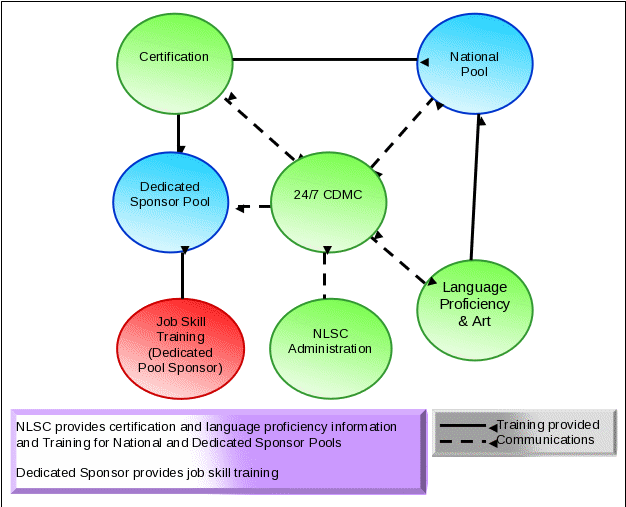
The individual training provided by the NLSC includes Member readiness for both the National and Dedicated Sponsor Pools. It also includes providing information and materials for Members to maintain their language proficiency and develop awareness for the art of using language skills in the performance of roles that could include interpretation, translation, and instructing. The Dedicated Sponsor provides Members of the Dedicated Pool with job skill training. Members of the National Pool are not normally provided job skill training unless there is a specific requirement that has been approved as an exceptional case.
It is anticipated that the NLSC will provide language support services as a member of a Government Team. Developed team skills are not necessarily present in civilian environments. To reduce the risk of performance that is dysfunctional and counterproductive, the NLSC must ensure its Members are prepared to function as a member of an integrated team. Consequently, team training, as a component of Member Readiness, is an important part of preparing NLSC Members for success.
Figure 3.2.6.2-4 illustrates NLSC-sponsored team training for Members of the National Pool. In this example, NLSC Operations identifies and engages a Government sponsor participant, develops a scenario, forms an operation team to conduct the training, organizes a team of National Pool Members, and uses the scenario as the basis for conducting the training. The 24/7 CDMC provides communications for the training and NLSC staff provides functional support. The Government sponsor performs the role it would normally perform in the scenario during its participation in the training.
Figure 3.2.6.2-4: Sponsored Team Training
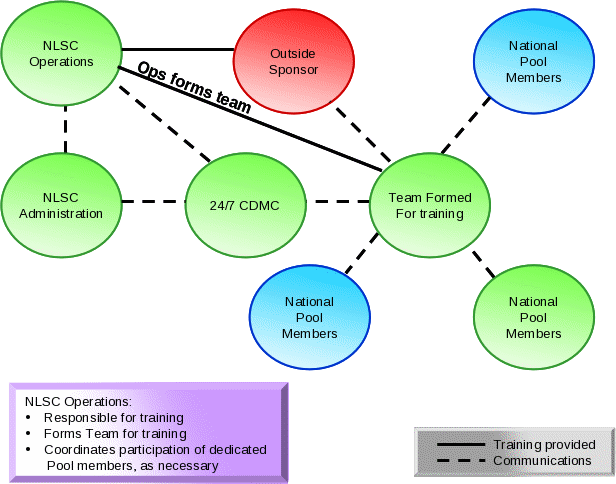
Team training is also anticipated for Members of the Dedicated Sponsor Pool, as illustrated below.
Figure 3.2.6.2-5: Dedicated Sponsor Team Training
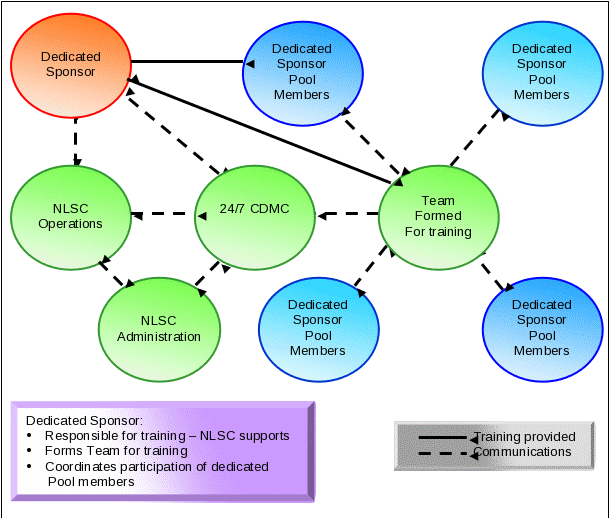
In the example Figure 3.2.6.2-5, a Dedicated Pool Sponsor requests NLSC support for forming a team of Members from the Dedicated Pool for training. The Dedicated Sponsor would normally assume the lead for preparing the training scenario and supporting events and for conducting the training. When this situation occurs, NLSC operations, staff, and 24/7 CDMC perform normal functions during their participation of the training.
The NLSC may also conduct team training without the participation of an outside sponsor, as illustrated below. An example of the rationale for conducting this training could be to prepare the NLSC staff and Members to support different scenarios or to prepare for training and/or exercises sponsored by an outside agency. The team formed for training could include NLSC Members from both the National and Dedicated Pools to provide an additional, interesting, and potentially useful variation in the participants.
Figure 3.2.6.2-6: NLSC-Sponsored Team Training

NLSC Operations would normally be responsible for the training and would prepare the scenarios, form the teams for training, coordinate the participation of NLSC Members and conduct the training.
Language proficiency decays over time unless it is used and the sustainment of language skills represents a major challenge for the NLSC. Consequently, sustaining language skills is a high NLSC priority. The CONOPS for sustaining language skills is illustrated in Figure 3.2.6.2-7. Language skill maintenance is the responsibility of the individual NLSC Member. The NLSC is responsible for obtaining and making information and content available 24/7 to Members worldwide via the CDMC; however, it is the individual Member’s responsibility to use these materials to sustain their language proficiency. NLSC Operations has staff responsibility for monitoring language skill maintenance and for conducting periodic assessment and certification of language proficiency skills as directed by NLSC policy.
Figure 3.2.6.2-7: Language Proficiency Training
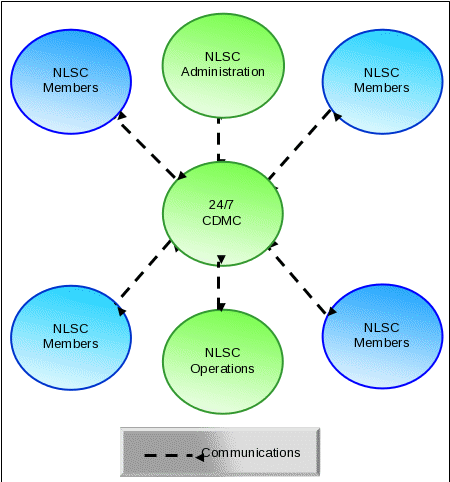
3.2.6.3Staff Responsibilities
Responsibility for the NLSC Language Proficiency Training and Member Readiness CONOPS includes a number of staff members. Plans & Policy establishes training plans and policies, integrates training in budget requests, allocates resources to training, monitors training expenditures, and integrates training progress results into NLSC reports. Operations has overall staff responsibility for training including language skills, the art of using language skills, and certification; determining Member training requirements; establishing standards for training and education and training materials; validating education and training materials to be posted for use; and determining training resources and materials. Operations also forms teams for training; notifies NLSC Members of training; coordinates outside sponsors and participants; approves and issues training authorizations; authenticates and provides training results to Human Resources; issues documents of training results, e.g. certificates; prepares training budget; prepares training metrics; and measures and reports training results.
NLSC Human Resources staff documents training in personnel records; provides personnel records to the CDMC; takes appropriate personnel action in response to training; e.g. certificates, press releases, and sponsor notification; and includes results in personnel metrics. Supply and Services obtains and issues approved training resources and monitors training resource expenditures.
The 24/7 Communications and Data Management Center supports training activities through its electronic and digital hub; provides the communication center and databases for training; provides databases for education and training materials; provides electronic portal links to websites; enters new data in personnel database; and extracts and presents personnel data upon request.
3.2.6.4Training and Readiness Criteria
The criteria for successful NLSC training include providing information and training that ensures the readiness of Members and the organization to meet the needs of User organizations. This readiness includes individual readiness and sustainment of language proficiency. NLSC training assesses and certifies the language skill proficiency of Members; supports language proficiency maintenance; informs Members in the art of using language skills in performing interpretation, translation, and instruction; supports individual Member responsibility language skill enhancement that does not involve formal education; prepares and qualifies its staff, including recruiters; and interfaces with existing language instructional environments. The NLSC training records for each Member are maintained in a secure electronic database located in the 24/7 CDMC.
Members conduct individual and team language training with education and training materials provided via the 24/7 CDMC that leverages COTS/GOTS and existing IT infrastructures to meet the information technology requirements of the NLSC.
Table 3.2.6.4-1 defines the relationships and interactions with and in support of other NLSC functions and activities.
Table 3.2.6.4-1: Functional Relationships and Interactions
Function: Training and Readiness |
|
Function/Activities |
Relationships/Interactions/Support |
Director
|
Comply with guidance from the Director. |
Deputy Director
|
Comply with guidance from the Deputy Director. |
Plans & Policy
|
Determine budget necessary to support staff and Members/Use lessons learned to evaluate and improve processes and procedures.
|
Marketing |
|
Operations
|
Provide relevant instructional material for use in the CDMC/Ensure Member and Staff information is current and accurate/Identify well designed training programs to be used by Members and Staff. |
Supply & Services
|
Purchase Commercial-off-the-Shelf training products/Make facility arrangements for off-site training as required/Ensure equipment and supplies are available. |
Security
|
Comply with guidance for protection of information technology. |
Human Resources
HR Support |
|
Recruiting |
Utilize available resources to improve sales techniques. |
3.2.6.5Metrics
The training and readiness metrics being used to ensure that criteria are being met are provided in Table 3.2.6.5-1.
Table 3.2.6.5-1: Metrics Definition
Training & Readiness |
|
Description: NLSC training and readiness develops and sustains the skills of Members, staff, and recruiters necessary for an effective, fully operational NLSC to perform its mission in normal and emergency situations. NLSC training also provides information necessary for members of the User community to understand and use the NLSC |
|
Goal: Provide information and training necessary for a fully operational NLSC with Members and staff possessing the capabilities necessary for meeting the language skill and readiness requirements of the User community in both normal and emergency situations. |
|
Metric: NLSC Members, staff, and recruiters have the skills and information necessary for meeting the language skill and readiness requirements of using organizations as measured by customer feedback of 95% or greater. |
|
Measure of Performance |
Data Elements |
Individual language proficiency sustainment
|
Number of NLSC Members NLSC Members
Measures of success: 1) Increase in number of members participating in the language sustainment resources 2) Decrease in non participation by members 3) Positive feedback from members on materials offered |
Individual readiness training
|
Number of NLSC Members NLSC Members
Measures of success: 1) Reduction in time to complete online training 2) Positive feedback from members on the quality of the information provided in the training material |
Team training |
Number of NLSC Members NLSC Members
|
Art of using language skills in the performance of:
|
Number of NLSC Members NLSC Members
|
NLSC staff training
|
Number of NLSC staff members NLSC staff members
|
NLSC recruiter training
|
Number of NLSC recruiters NLSC recruiters who:
|
Metric: NLSC training is available to Members, staff, and recruiters worldwide, 24/7 |
|
Measure of Performance |
Data Elements |
Training provided |
NLSC Members receiving training
|
|
NLSC staff receiving training
|
|
NLSC recruiters receiving training
|
Metric: User communities have the information necessary for understanding and using the NLSC |
|
Measure of Performance |
Data Elements |
Information concerning NLSC provided |
Number of participating Government agencies with language requirements
|
User community use |
Number of participating Government agencies with language requirements
|
Metric: NLSC training leverages and uses for existing education and training technologies, methodologies, materials, and IT infrastructure |
|
Measure of Performance |
Data Elements |
COTS/GOTS technologies
|
|
Education and Training Methodologies
|
|
Education and Training Materials
|
|
3.2.7Activation, Deployment and Redeployment
3.2.7.1Assumptions
The assumptions inherent to the activation, deployment, and redeployment of NLSC Members in support of User requests are:
The Communications and Data Management Center (CDMC) has been established and is operational with 24/7 capabilities
Appropriate staff will be available to perform the workload and will be properly trained
Activation requirements will be established to include NLSC Member, User, and Member’s Employer’s rights and responsibilities
Member Data and Requester Data Sheets will be available
Requisition methods will be finalized
Members are available for activation, deployment, and redeployment
Authority to activate, deploy, and redeploy Members exists
Federal, state, and local government agency and NGO User requirements for certified language competent personnel exceed existing capabilities.
The NLSC and User organizations will enter into Memorandums of Agreement (MOA) that will articulate, to the extent practicable, the employment and utilization of Members for validated operations. MOAs represent the culmination of advanced deliberate planning between the NLSC and Users and are intended to expedite the NLSC’s response to User requests. However, the absence of established MOAs or requirements that have not been previously identified or anticipated will not preclude a timely NLSC response for requests for immediate support.
NLSC Members:
are proficient in English and possess certified proficiency in one or more designated foreign languages;
have completed NLSC enrollment, orientation, and readiness training;
will be designated as either Dedicated Sponsor or National Pool Members; and
meet requirements for being activated and deployed
3.2.7.2CONOPS
This CONOPS describes actions to be taken for the Activation, Deployment, and Redeployment of NLSC Members to ensure that:
User’s request for support will be satisfied in a timely and efficient manner
NLSC Members who volunteer for activation and deployment are provided the means to render the best possible support
Member mission-related needs prior to, during, and after the activation are met
Figure 3.2.7.2-1 provides the key steps and relationships in the activation, deployment, and redeployment process. These actions cover deliberate, preplanned and emergency User requests and are applicable to Dedicated Sponsor and National Pool Members.
Figure 3.2.7.2-1: Activation, Deployment, & Redeployment Process
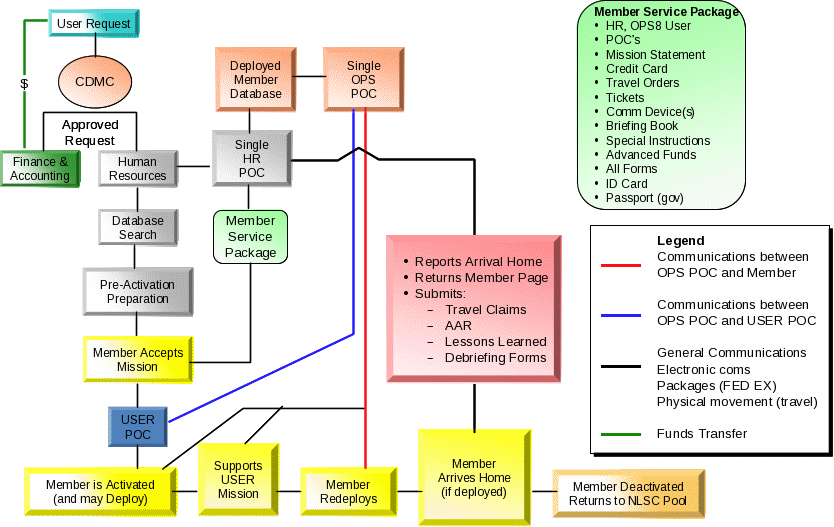
The activation process begins when a User’s request for language competent Member support is received through the CDMC. A User request for NLSC support takes precedence over all other NLSC activities and will be passed to the appropriate NLSC staff personnel as expeditiously as possible for urgent action. Requests for non-emergency support will be handled in a timely and efficient manner but may be integrated into the normal day-to-day operations of the NLSC.
A User may provide an “alert notification” via the telephone or other means, (e-mail, fax, etc) to get the process rolling. However, a formal, NLSC request form completed by the User is required to ensure the NLSC receives the information needed to determine if the request is from an authorized User and can be satisfied with NLSC resources.
When a User request for support is received through the CDMC, Operations assigns a Mission Number to the request and reviews it to ensure that the information needed to satisfy the request has been provided. If the request is appropriate for the NLSC, Operations will approve it, advise the User of the NLSC’s decision, and simultaneously forward it to Human Resources.
When NLSC receives an urgent User request after normal working hours, a NLSC staff member will take appropriate action. Under certain conditions, the Operations may “activate”; during this activation, key NLSC staff will conduct and monitor Member activation procedures and mission support operations. It is anticipated that activation by Operations will occur during periods when numerous requests for support are received nearly simultaneously or when large numbers of NLSC Members are activated and deployed.
Upon receipt of an approved request, Human Resources (HR) will conduct a search of NLSC Member data files to identify Position Candidates that meet the User’s needs in both numbers and capabilities. Typically, HR will identify a number of Position Candidates that is greater than the number required to meet the User’s need. A representative from HR will contact the Position Candidates to tell them of the potential activation and deployment and to determine their volunteer status.
HR will report the results of its Member data search to Operations along with detailed information on all Position Candidates that have agreed to be activated and deployed. The Operations Center will provide this information to the User for review and final Position Candidate selection. If the User is not available to make a selection or if this is an emergency request, HR will make the final determination as to who will be activated and deployed. Position Candidates selected for activation and deployment will be identified to the Operations Center and other appropriate NLSC staff elements. HR will contact all Members initially queried to inform them of their activation status. The personnel records of all contacted Members will be annotated accordingly.
Once a decision has been made as to which NLSC Members will be activated and deployed, an HR staff member trained in NLSC Member activation procedures will be designated as the Member’s single-point-of contact for all matters, and remains so until the Member departs his or her home. At the time of notification of activation, various NLSC staff elements will begin the activation process, which includes the creation of a Member Service Package (MSP). MSPs are unique to each mission and will be provided to the Member by the most expeditious means possible, typically by overnight express. The contents of the MSP are developed by various NLSC staff elements and delivered to HR for assembly and delivery to the Member.
The Operations Center will prepare a mission briefing book, which will include, but is not limited to:
Activation Orders (provided by HR) and commercial travel documents (provided by Supply and Services)
User Organization, Primary point-of-contact (by name and grade) and contact information
Unclassified mission statement
Anticipated duration of the activation and deployment
Force Protection issues and concerns
Indigenous Health Risks
An extract of the NLSC/User MOA that addresses administrative and logistics support (food, shelter, transportation, health service support, communications, etc.) that the User organization has agreed to provide the Member during activation and deployments
Country or area information
NLSC OPS Center point-of-contact and communications links
Special Instructions
HR’s contribution to the MSP includes Member activation orders, Member prepositioned Government ID cards, and Government Passports (issued during the Member enrollment process and maintained by the NLSC until needed). The Special Instructions and Authorization paragraphs of Member activation orders will include per diem rates and specifically state what welfare and comfort and necessary mission-related expenditures are authorized during the activation and deployment. Typically, expenditures should only be authorized for necessary goods and services the User organization has not agreed to provide or is not capable of providing. All financial information contained on the orders will be provided to HR by Finance and Accounting.
Supply and Services will provide commercial travel arrangements (i.e. tickets) if required as well as any support gear that may be required but not supplied by the User.
Finance and Accounting will issue a Government Credit Card, if required, in the Member’s name and an authorization for advanced funds (if requested by the Member). These items will be delivered to the HR POC for inclusion in the MSP. Finance and Accounting will also communicate directly with the User POC or designated representative to coordinate reimbursement for NLSC support services requested. Support cost and rates for NLSC services will be negotiated and documented in User agreements. When the cost of the requested support and services has not been previously coordinated, the NLSC Operations Center will inform a User of the cost at the time the request is received. Cost to Users will be based on a Language Services Schedule that will be updated annually or as necessary by the Finance and Accounting department and maintained in the Operations Center for this purpose. The absence of an advance transfer of funds from the User organization to the NLSC will not be justification to deny the requested support.
The NLSC Information Technology (IT) function will acquire and configure appropriate communications devices for the Member’s use during the deployment. These devices may include, but are not limited to: a cell phone, a satellite phone and a laptop computer. All communications and IT equipment assembled for the mission must be configured to operate in the designated Area of Responsibility (AOR). The IT department will also ensure that operating instructions accompany each piece of equipment. Laptop computers will be Internet capable, will have an active Member e-mail account, and will be configured to function in English and in the native language for the mission AOR. In addition, forms (HR, travel claim, finance, etc.), NLSC Standard Operating Procedures, and other pertinent documentation will be loaded onto the computer. This information and documentation will comply with predetermined NLSC activation, deployment, and redeployment procedures. Material prepared by IT will be delivered to HR for inclusion in the MSP.
HR will assemble the MSP and prepare an inventory form that lists its contents. The MSP will be sent to the Member at an agreed location such as the Member’s home and in sufficient time to allow for familiarization and requests for NLSC assistance, if needed. The Member will sign and return an MSP inventory form to HR.
At the appropriate time, the Member will be activated and possibly deploy with NLSC activation orders. Deployed Members may be directed to proceed to a forward staging area in the Continental United States (CONUS) or overseas or, directly to the AOR. In all cases, upon arrival at the designated location, the Member will seek and report to the POC designated by the User.
During activation and deployments, the NLSC is responsible for monitoring and, if necessary, intervening in order to influence the Member’s welfare, health and safety, and ensuring the satisfactory accomplishment of the mission. Throughout the activation, deployment, and redeployment all communications between deployed Members and the NLSC will be through the Operations Center.
Deployed Members confirm arrival with the Operations Center when they reach their assigned destination. Subsequent communications during the deployment will occur as needed. Periodic status reports may be required to ensure the Member’s health and welfare and that the mission is being accomplished satisfactorily.
Upon completion of the mission the Member, if deployed, will redeploy to his or her home. If assistance with travel arrangements is required, it will be coordinated through the Operations Center and prepared by Supply and Services. Before release by the User and departure from the AOR, the Member will confirm his or her travel itinerary with the Operations Center. The Member will contact the Operations Center upon arrival home.
The Member will be contacted by HR and advised that he or she is deactivated from Federal Service and asked to complete the appropriate documentation to effect that transition. Within five working days, the Member will prepare and submit an After Action Report, a Lessons Learned Report, required Mission Debriefing Documents, travel and other claims. These documents will be forwarded to the Operations Center for appropriate action. The Member will return all MSP items to HR via overnight express mail.
The Member’s records will be updated promptly by HR to reflect Federal Service and appropriate mission-related events. Upon completion of all post-activation activities, the Member will be reverted to NLSC’s inactive status either as a Dedicated Sponsor or National Pool Member.
Table 3.2.7.2-2 defines the relationships and interactions with and in support of other NLSC functions and activities.
Table 3.2.7.2-2: Functional Relationships and Interactions
Function: Activation, Deployment and Redeployment |
|
Function/Activities |
Relationships/Interactions/Support |
Director
|
Comply with guidance from the Director. |
Deputy Director
|
Comply with guidance from the Deputy Director/ Provide Public Relations support to inform the public about NLSC/ Receive and process Member and User complaints. |
Plans & Policy
|
Create and disseminate reports based on data gathered from Members and Users who were active participants/ Review and maintain Memorandums of Agreement between the User and NLSC/ Establish relationship with Users to determine needs. |
Marketing |
Use Member experiences in developing marketing materials. |
Operations
|
Notify the User of Position Candidates for deployment/ Serve as the liaison between the User and Member/ Prepare mission briefing book. |
Supply & Services
|
Provide adequate telecommunications/ Make necessary travel arrangements/ Make available equipment and supplies necessary to complete the mission. |
Security
|
Ensure Security Briefs are provided to Members/ Provide instruction for the protection of personal information/Follow-up on security clearances as required. |
Human Resources
|
Compile list of Position Candidates/ Assemble Member Service Packages/ Maintain Member service records. |
Recruiting |
Work to eliminate member shortfalls. |
3.2.7.3Metrics
The metrics being used to ensure that criteria are being met are provided in Table 3.2.7.3-1.
Table 3.2.7.3-1: Metrics Definition
Activation, Deployment, and Redeployment |
|
Description: Activation, Deployment, and Redeployment is the use, movement, tracking, support, and return of people from a job and/or job employment site for the purpose of accomplishing a stated mission. |
|
Goal: Effectively, efficiently, and safely use and potentially move NLSC members from their homes to Federal, State or locally determined employment sites in time of crisis, national emergencies, or for National Security purposes. To provide appropriate support to NLSC Members during their activation and deployment. If deployed, to effectively, efficiently, and safely return NLSC Members from their deployed locations to their homes. |
|
Metric: National Language Service Corps Members arrive in place on time and prepared to accomplish their missions. Upon mission completion, they return home safely and in a timely manner. |
|
Measure of Performance |
Data Elements |
Effectiveness/Efficiency of Activation/Deployment |
Methodology: Data capture and analysis for first six months. Success: 1) Increase completeness of Requester Information 2) Decrease time from notice of emergency need to date Member is in place 3) Increase readiness of Members to be activated and deployed |
Effectiveness/Efficiency of Redeployment/ Deactivation |
Methodology: Data capture and analysis for first six months. Success: 1) Increase ease of redeployment actions for Member and User; 2) Streamline redeployment/deactivation documents |
Efficient support for Members Needs
|
Methodology: Data capture and analysis for first six months. Success: 1) Increase percent of initial responses within 24 hours for urgent query and 72 hours for routine queries; 2) Decrease number of NLSC controllable reasons for User/Member grievances; 3) Decrease number of errors in Member records. |
3.2.8Communications and Data Management Center (CDMC)
3.2.8.1Assumptions
The assumptions supporting the CDMC CONOPS are provided below:
CDMC operations include 24/7 worldwide access and distribution of education, training, and information materials as well as data to support the full range of NLSC operations, and a Help Desk that provides both language and technical assistance or support
The NLSC community of interest (Members, staff, Users) have internet access to and are able to use the 24/7 CDMC from locations worldwide; when necessary, the NLSC will train Members to use the internet on a case-by-case basis.
NLSC information and materials will be delivered electronically 24/7 worldwide to the individual Member’s location
Commercial off-the-shelf (COTS) hardware, software, technologies, and infrastructures have capabilities sufficient to meet the CDMC requirements for IT and content; databases will have to be developed and configured to satisfy NLSC requirements
The NLSC will identify Member and staff responsibilities for web-based interactions, and Members and staff will accept these responsibilities
The NLSC will identify incentives that motivate Members and staff to successfully use web-based interactions
The NLSC will prepare Members and staff to use the internet to access CDMC technologies, information, and materials
3.2.8.2CONOPS
The CDMC is the NLSC’s central data and communications center providing an electronic and digital hub for performing NLSC functions and responsibilities; building a sense of community and belonging among Members, the User community, and NLSC staff; and information sharing. The CDMC supports the NLSC mission for providing and maintaining a readily available civilian corps of certified expertise in languages determined to be important to the security and welfare of the nation by:
Providing a one-stop-shop resource for clients to register and request services
Functioning as a repository of qualified, certified language competent individuals (Members) who are ready to serve
Offering Members necessary information and training
Providing data necessary for NLSC planning, operations, and management
Functioning as the organizational hub of all human resources and operational activities
The CDMC CONOPS supports a fully operational NLSC that is initially a DoD-sponsored organization; establishes a public presence on the Internet; supports a beta-test population of up to 1,000 Charter Members during the prototype; and serves as a one-stop-shop for NLSC staff, Members, and clients to conduct communication and access to information. The CONOPS also includes support for languages of interest to the NLSC with an internet-based, 24/7 training support center.
The CDMC supports NLSC growth as the organization’s Members increase and its mission and clientele expand. In addition to serving the Member population and building a sense of community throughout the organization, the CDMC supports the staff performing program management, human resources, financial management, and technical support for the day-to-day operations of the NLSC. The business processes of the organization are enabled through an Online Management Center. This Online Management Center contains features that support Recruiting, Human Resources, Finance, Language Proficiency Assessment, Reporting, Customer Support, Documentation; Operations, Quality Assurance, Marketing, Information and Training, Logistics, and Requirements.
Figure 3.2.8.2-1, the CDMC includes the databases necessary for supporting the performance of the Office of the Deputy Director, Plans and Policy, Operations, Human Resources and Supply and Services.
Figure 3.2.8.2-1: 24/7 CDMC
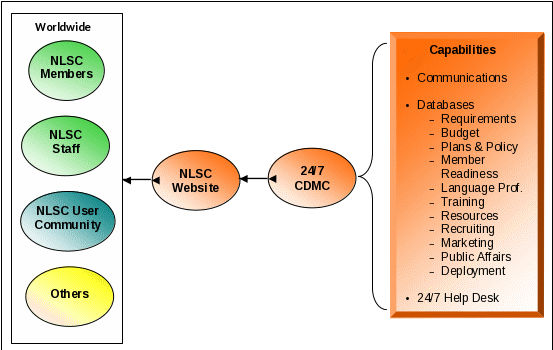
The capabilities of the CDMC also support collaboration among its users with a common data library and management system and synchronous collaborative system (Macromedia Breeze by Adobe). These capabilities include reach back through a web-based content delivery system. A web-based chat system will be used for coordination among geographically dispersed, 24/7 network engineering staff. This system will be integrated with the trouble ticketing system so that all new trouble tickets will notify staff via email and post messages into the chat application and its continuously updated archive capability.
The Help Desk provides Members access to staff for responding to non-language related questions such as those related to personal issues, training, deployments and redeployments, or the use of information technology. The Help Desk also receives and responds to language-related issues by directing the caller to someone with the necessary expertise for responding to questions or issues associated with different languages. The CDMC provides electronic 24/7 access and distribution of information, education, and training materials worldwide. It also supports outreach programs across the NLSC community of interest (Members, staff, and Users) and a platform for developing a sense of identity and community during activation and deployment.
The CDMC CONOPS includes synchronous and asynchronous web-based training for the delivery of education and training over the internet through a web portal that can be facilitated with or without an instructor. The CDMC includes collaborative environments and tools available through an adaptable website that contains an online digital library as a place to share events, announcements, tasks, and contacts. When a document is complete, NLSC staff can post the document to a public folder that automatically makes it accessible from the NLSC website through the Digital Library search engine. These capabilities enable NLSC staff and Members to perform functions, such as profile updates, training, as well as communicating and collaborative interactions.
The Online Customer Request Processing Center provides a capability to operate as an electronic performance support system, guiding the customer through the “request for services” process. The system also provides e-mail alerts to users, as a reminder of incomplete tasks. All of these operations will be accessible via the Internet in a one-stop-shop approach. The CONOPS for the CDMC envision it as a “comprehensive” and “user-friendly” data, communication, and information center that is available 24/7 via the internet from locations worldwide.
One of the constraints considered during the design, development, and implementation phases of the CDMC is the status of the NLSC as a Federal agency, which denotes that the web page must be formatted in accordance with OSD standards and compliant with Section 508, and must take into account the assumption that personal data will be collected and stored on the portal’s databases with associated required security standards being in place.
The NLSC website serves as the gateway to the CDMC for the general population with an interest in languages and language support services. It also functions as the official portal for NLSC staff, Members, and Users to carry out their respective operations. Functional, aesthetic, and technical requirements drive the conceptualization of the portal. As such, all of the following factors affect the architecture design: consideration of business process issues and requirements; evaluation of recommended technical specifications; assessment of the content and navigation issues; and consideration of graphic and Human Performance Interface (HPI) issues. The challenges being exposed in the development of this site are being addressed in an iterative process that supports development activities for a scalable and modifiable portal. The basic CDMC design is provided in the flow diagram.
Figure 3.2.8.2-2 illustrates the 24/7 homepage and its general navigation schema. The homepage is the all-purpose entry point for all users to the CDMC. When the web address is entered or the link is clicked from a search engine, this page appears. Its content provides an overview, describing the organization and its mission.
The links off the homepage allow navigation to secondary pages as indicated in each drop-down menu. The following are planned as links off the homepage:
Figure 3.2.8.2-2: CDMC Portal Homepage Diagram
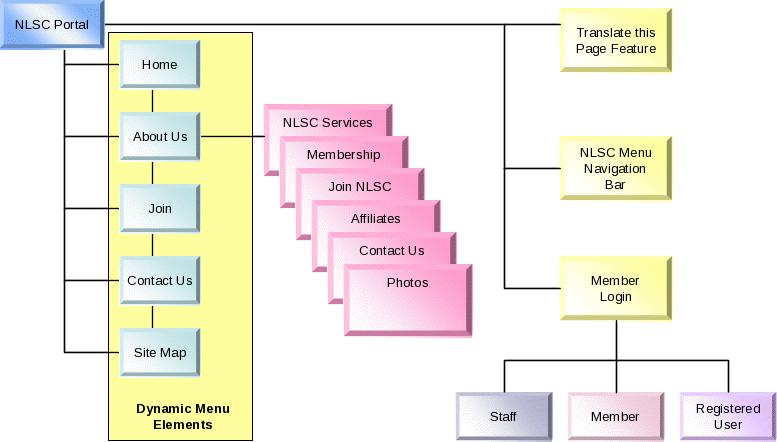
About Us—this link explains the NLSC mission and purpose in detail. It also contains a link to Frequently Asked Questions.
Our Services—this link offers information about the support the NLSC is prepared to give its clients.
Our Members—this link provides information about desired Prospect qualifications what is needed to apply.
Our Clients—this link provides a brief overview of who the Users are and how they use NLSC services.
Our Affiliates—this link describes NLSC partner organizations.
Our Relevant Links or Our Photo Gallery—these links are being suggested. The recommendation is to use the “Our Relevant Links” in the pilot phase to connect visitors to relevant organizations. The link for “Our Photo Gallery” is another option once the program is launched in earnest and Members have completed assignments.
Drop down menus are paired with each link to provide a bird’s eye view of the additional information that is available from this portal. Figure 3.2.8.2-3 and Figure 3.2.8-4 depict the plan for the content of each of the menu buttons:
Figure 3.2.8.2-3: Navigation Bar Drop-Down Menus
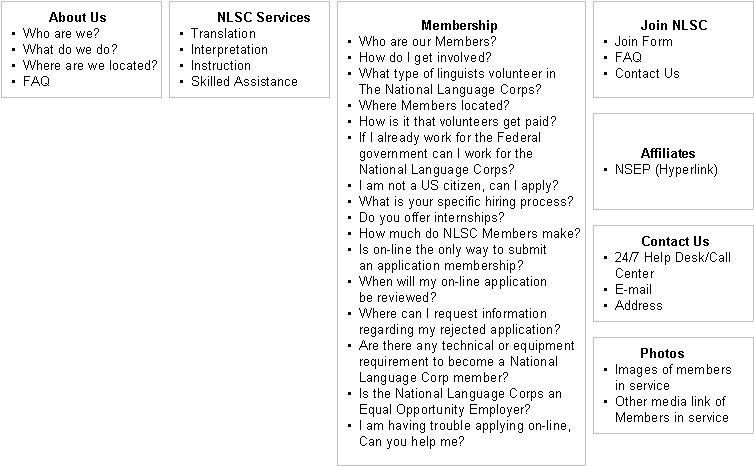
Figure 3.2.8.2-4: Frequently Asked Questions
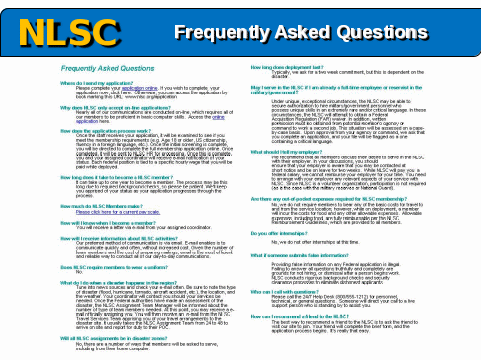
Log In fields provide access to password protected areas in the CDMC. These areas are only open to staff, Members, and registered Users of NLSC services. The username and password combinations are mapped to roles and permissions on the portal’s database, thus routing the individual to the appropriate location on the portal. This design will only grant those who are cleared to log in to the secured areas access to the partition of the portal that is mapped to their approved roles and permissions. Thus, Members will not be able to access the Registered User partition, nor will the Registered User gain entry into the Member partition. Specific staff will have access to all three partitions, based on their roles and permissions, which are business-rule driven.
The staff flow diagram in Figure 3.2.8.2-5 depicts the components and features of the Staff homepage.
Figure 3.2.8.2-5: Staff Homepage Flow Diagram
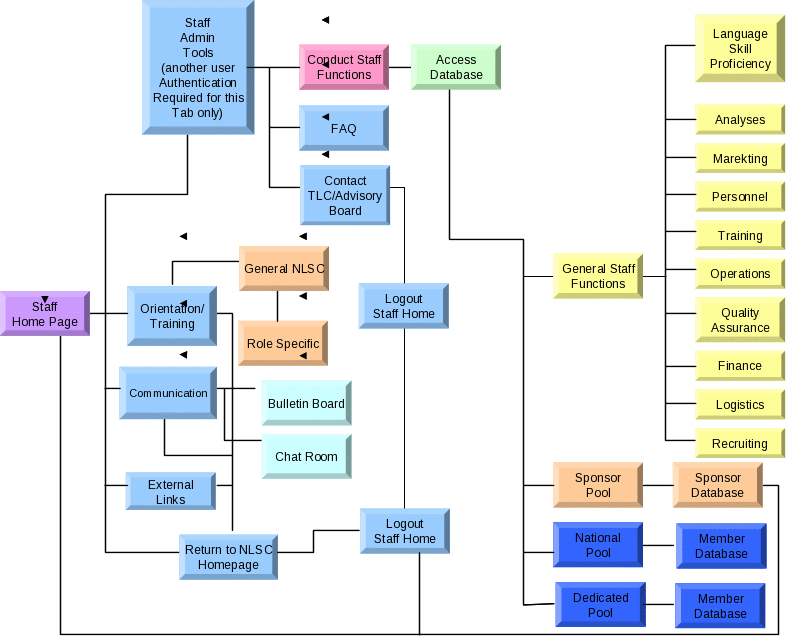
Figure 3.2.8.2-6 depicts the components and features of the Member homepage.
Figure 3.2.8.2-6: Member Homepage Flow Diagram

Figure 3.2.8.2-7, the registered user flow diagram, depicts the components and features of the User homepage.
Figure 3.2.8.2-7: User Homepage Flow Diagram

The overall site design supports User requirements and provides information about the NLSC to the general public. It delivers day-to-day operational support to the organization’s staff (including basic HR functions and case load processes); one-stop-shop support for NLSC staff and Members to process necessary paperwork; access to NLSC orientation material, as well as language proficiency training (COTS) applications; 24/7 worldwide communications via message boards, instant messaging (chat rooms), and other coordinated events; support to the User base in the full cycle of needs associated with using NLSC services. Furthermore, it builds a sense of community across the NLSC.
The design considers and reflects the influence of aesthetic appeal in the look and feel of the site in order to appeal to volunteerism; look vibrant and inviting using patriotic colors (red, white, and blue); have global appeal; portray diversity; give a sense of “people helping people”; and motivate others to help their fellow man by selecting graphics that show people from a wide range of occupations and age groups (minimum age of 18). The design also incorporates general technical requirements that include usability considerations, interaction design (intelligent agent), User-centered features, and Section 508 compliance. Other portal design technical considerations include:
Cascading style sheets used for a uniform look and feel
Page Translation capability
Visitor Counter and map clusters (http://clustrmaps.com) for data collection
Databases to search for the User's information and generate web pages on demand
Trouble tickets
Search capability
Single sign-on
Comprehensive Back-up and recovery
Security and Privacy assurance
Accessibility (readable using a screen reader)
Minimal use of JavaScript or active elements (assists with performance for dial-up users)
Databases to support the communications center (tentatively recommended COTS application is SharePoint), training center (tentatively recommended COTS application is Blackboard), and HR Center (tentatively recommended for near term a proprietary application; long term recommendation PeopleSoft)
3.2.8.3Staffing
The CONOPS for staffing the CDMC is provided in Table 3.2.8.3-1.
Table 3.2.8.3-1: CDMC Staffing
Position |
FY 2011 |
FY 2012 |
FY 2013 |
FY 2014 |
FY 2015 |
CDMC Manager |
1 |
1 |
1 |
1 |
1 |
Senior Database Administrator |
1 |
1 |
1 |
1 |
1 |
Database Administrator |
2 |
2 |
2 |
2 |
2 |
Senior System Architect |
1 |
1 |
1 |
1 |
1 |
System Architect |
1 |
1 |
2 |
2 |
2 |
System Support Technician |
1 |
2 |
2 |
2 |
2 |
24/7 Help Desk |
4 |
6 |
8 |
8 |
8 |
This staffing plan enables the CDMC to increase its capabilities as the NLSC grows in numbers and expands its activities across an increasing number of supported organizations.
Table 3.2.8.3-2 defines the relationships and interactions with and in support of other NLSC functions and activities.
Table 3.2.8.3-2: Functional Relationships and Interactions
Function: CDMC |
|
Function/Activities |
Relationships/Interactions/Support |
Director
|
Comply with guidance from the Director/ Abide by the rules and regulations that govern information technology. |
Deputy Director
|
Comply with guidance from the Deputy Director/ Abide by the rules and regulations that govern information technology/ Ensure appropriate disclaimers are listed on the website. |
Plans & Policy
|
Provide lessons learned to be stored in an area designated for Staff.
|
Marketing |
Use data collected to determine marketing strategies and approach. |
Operations
|
Distribute education/training and information materials to support NLSC/ Utilize a Help Desk to provide technical support and language assistance/ Deliver information materials electronically 24/7 to locations worldwide/ Use Commercial-off-the-Shelf products. |
Supply & Services
|
Ensure equipment and materials are available to support a 24/7 operation/ Make necessary arrangements with vendors and contractors to ensure minimal service interruption/ Select facilities that can support a 24/7 operation. |
Security
|
Ensure a secure network is installed in the facility where the CDMC is located/ Conduct security checks of the facility to prevent unauthorized access or mishandling of information/ provide a secure working environment for day-to-day operations. |
Human Resources
|
Access data collected and stored to identify Members for activation/deployment/redeployment. Maintain and update Staff and Member service records/ Communicate with Members and Staff. |
Recruiting |
Utilize the leads generated from the website/ Review reports that measure recruiting efforts. |
3.2.8.4Metrics
The metrics being used for measuring and reporting CDMC progress are provided in Table 3.2.8.4-1.
Table 3.2.8.4-1: Metrics Definition
CDMC |
|
Description: Data center and electronic and digital communications hub for performing NLSC functions and responsibilities; building a sense of community and belonging among Members, the User community, and staff; and information sharing by providing a one-stop-shop resource for Users to register and request services; serving as a repository of qualified, certified language competent individuals (Members) who are ready to serve; offering Members necessary information and training; and functioning as the organizational hub of all human resources and operational organizational activities. |
|
Goal: Provide data, information, and training available 24/7, worldwide necessary for a fully operational NLSC with Members and staff possessing the capabilities necessary for meeting the language skill and readiness requirements of the User community in both normal and emergency situations. |
|
Metric: Data, information, and training necessary for a fully operational NLSC available 24/7 worldwide. Measured by 95% customer satisfaction and assessed by Members, Users, and the staff. |
|
Measure of Performance |
Data Elements |
NLSC functions
|
Number of functions:
|
User satisfaction
|
Number of
Number of trouble tickets
Number of complaints Feedback
|
24/7 Operations
|
Access and distribution of information and training materials
|
24/7 Help Desk operations |
Support provided
|
Trouble Tickets |
|
Worldwide Delivery |
Number of:
|
Data Efficiency |
Number of data elements
|
COTS-Based Operations |
Number of:
|
Compliance |
Number of applicable:
|
Redundancy |
Number of:
|
CDMC Staffing Levels |
Number of staff:
|
Security |
Number of Security related elements present in the CDMC
|
CDMC Staffing Skill Levels |
Number of staff:
|
The metrics support CDMC management reports with information about the types of problems reported, the source of the trouble ticket, and the amount of time required to resolve the problem.
3.2.9Program, Plans, and Budget Execution (PPBE)
3.2.9.1Assumptions
The assumptions supporting the NLSC PPBE CONOPS are provided below.
The NLSC is an investment in the security and welfare of the nation and, as an investment, the organization is expected to deliver a favorable return.
The NLSC appeals to service for the greater human good by focusing on motivation of individuals with language skills to use these skills in support of others, which reduces recruiting costs and increases the Membership retention rate.
Eighty-five percent of NLSC Members will serve in the National Pool; 15% will serve as Members in the Dedicated Sponsor Pool.
Eighty-five percent of Members will continue to serve in the NLSC.
Ninety-nine percent of Member Applicants will successfully complete the National Agency Check (NAC)
Eighty percent of Member Applicants will complete language assessment and certification
Twenty percent of NLSC Members are activated annually; half of these will involve deployment, defined as activation that includes travel.
Annual inflation rate is 5%
Investment share
The NLSC funds its operations and those associated with non-deployed Members, including certification and Member readiness which includes activities such as orientation, exercises, User culture training, passports, wills, and shots;
Fifty percent of NLSC activations include deployment;
For deployments, NLSC funds initial five days of on-site labor and domestic travel costs to and from the Member departure site and the location of service;
Using organizations pay for services after initial five days and for travel to service sites located overseas
3.2.9.2CONOPS
The NLSC initially is an agency of the Department of Defense (DoD) and participates in the DoD budgeting processes. The requirements determined for the NLSC are used as the basis for preparing an initial document in July to start the formal budget development process. The budget line items and the algorithms used to calculate investments are provided below. This budget is further developed in a series of internal NLSC reviews and is available as a draft budget in January. The draft budget undergoes a series of additional NLSC and NSEP reviews and is available for submission to the DoD in May. The draft budget is integrated into the DoD POM/BES Electronic Database in August with NSEP providing detailed backup materials to the DoD in September. The budget is reviewed in a series of budget meetings conducted by the Office of the Secretary of Defense (OSD) in October and November. It is included in the November OSD Program Decision Memorandum and is part of the DoD budget lock in December for submission to Congress in February. The Director, NSEP supports the explanation of the NLSC budget to Congress as a Member of the DoD team. The NLSC staff is responsible for preparing the budget and supporting materials and providing support to the Director, NSEP throughout the annual process. These timelines for NLSC budget planning for DoD Program Objective Memorandum (POM) are summarized in Table 3.2.9.2-1 illustrated below.
Table 3.2.9.2-1: NLSC Annual Budget Cycle Timelines
NLSC Annual Budget Cycle Timelines |
|
The planning process and policy is connected directly to requirements that are based on national security and domestic needs Table 3.2.9.2-1 above. The PPBE process begins with User requirements to identify gaps in language capabilities that exist between “what is” and “what needs to be.” The gaps identified from User language priority requirements provide the basis for the NLSC budget and the allocation of resources to fill these gaps. The NLSC Membership levels being used for the FY11 – FY15 budget are provided in Figure 3.2.9.2-2.
Figure 3.2.9.2-2: NLSC Membership Goals
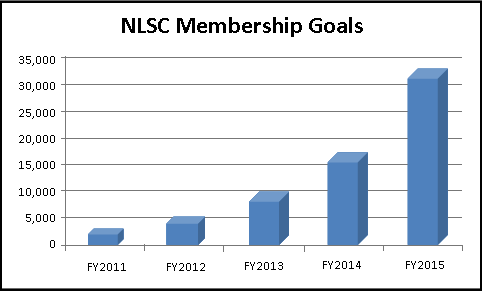
The initial five-year budget supports 100% annual NLSC growth from 1,000 Members at the end of the prototype to 2,000 Members in FY 2011 to 4,000 Members in 2012 through 8,000 Members in 2013 and 16,000 Members in 2014 to 32,000 Members in FY 2015.
Figure 3.2.9.2-3 illustrates the number of individuals the NLSC must recruit annually and that must be supported in the budget to obtain the required Membership levels. It includes the annual Member 15% attrition rate, 1% who do not complete the NAC, and the 20% who do not complete certification. The budget also includes line items for completing national agency checks, certification, and entries into NLSC databases as well as training and orientation for new Members.
Figure 3.2.9.2-3: Annual Recruiting Requirements
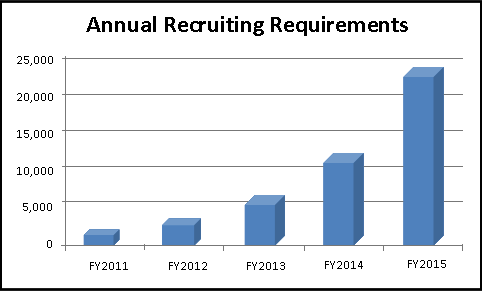
Four investment factors are used to determine the NLSC budget line items. These investment factors are:
New NLSC Members: investment per new Member
Existing NLSC Members: investment per existing Member
NLSC staff: investment per staff Member
NLSC functions: investment for performing functions supporting across the NLSC
The breakout of these investment factors for the NLSC budget is provided below (Table 3.2.9.2‑4). The table provides a detailed overview of the various primary (direct) and secondary (indirect) investment elements.
Table 3.2.9.2-4: NLSC Budget Investment Factors
NLSC Budget Investment Factors |
||||
Line Item |
New NLSC Members |
Existing NLSC Members |
NLSC Staff |
NLSC Function |
Operations |
|
|||
Operations Center |
|
|
|
|
Member Readiness |
|
|
|
|
Certification/Recertification |
|
|
|
|
Language Proficiency Training |
|
|
|
|
Plans and Policy |
|
|||
Requirements |
|
|
|
|
Marketing |
|
|
|
|
Programming & Budget |
|
|
|
|
Lessons Learned |
|
|
|
|
User Agreements & Liaison |
|
|
|
|
24/7 CDMC |
|
|||
Staffing |
|
|
|
|
Content |
|
|
|
|
Hardware |
|
|
|
|
Software |
|
|
|
|
Licenses |
|
|
|
|
Human Resources |
|
|||
Recruiting |
|
|
|
|
Pay and Benefits |
|
|
|
|
Member Agreements |
|
|
|
|
HR Support |
|
|
|
|
Office of the Director |
|
|||
General Counsel |
|
|
|
|
Inspector General |
|
|
|
|
Quality Assurance and AM&R |
|
|
|
|
Office of the Deputy Director |
|
|||
Public Affairs |
|
|
|
|
Equal Opportunity |
|
|
|
|
Legislative Affairs |
|
|
|
|
Finance and Accounting |
|
|
|
|
Medical Counsel |
|
|
|
|
Security |
|
|||
Staff Clearances |
|
|
|
|
Member NACs |
|
|
|
|
Info, Physical, & Ops Security |
|
|
|
|
Supply and Services |
|
|||
Facilities |
|
|
|
|
Procurement & Contracting |
|
|
|
|
Supplies |
|
|
|
|
IT Support & Infrastructure |
|
|
|
|
Transportation |
|
|
|
|
Operations
Operations Center: is the point of contact to all activated, deployed, and redeployed Members.
Member Readiness: pertains to new and existing NLSC Members and includes all facets of User culture training, operational training, and deployment preparedness.
Certification/Recertification: will be responsible for ascertaining the foreign and English language skills of new Members, recertifying existing Members, and maintaining records of available tests by language. Applies to all new and existing Members and includes self-assessment, language proficiency testing, re-certification, and test development.
Language Proficiency Training: serves to sustain language proficiency for existing Members by providing them with educational and information material, dialogue, and exchange.
Plans and Policy
Requirements: identifies and defines requirement of NLSC operations.
Marketing: will determine objectives; develop strategic messaging, marketing materials, and media relations; and construct a strategic bridge between potential Members and NLSC.
Lessons Learned: will survey Users and Members, analyze survey results, and develop recommendations for improvement of operational capabilities.
User Agreement and Liaison: The User Agreements and Liaison staff will conduct User interface and marketing to promote NLSC visibility and establish and maintain relationships with User organizations at the local, state, and federal level.
Programming and Budget: prepares and submits operating budgets for forecasted requirements.
24/7 CDMC
Staffing: will support the operational capacity of the center’s communication channels, databases, website, and 24/7 help desk.
Content: is responsible for information, education, and training materials.
Hardware: IT and telecommunications materials and equipment pertinent to the Center’s operations.
Software: IT and telecommunications applications and programs pertinent to the Center’s operations.
Licenses: IT and telecommunications licenses pertinent to the Center’s operations.
Human Resources
Recruiting: will hire and train recruiters, define target and determine recruiting quotas, develop recruiting materials, conduct community outreach to augment leads, and achieve specific target quotas.
Pay and Benefits: maintains information regarding staff and Member salaries and benefits.
Member Agreements: is responsible for sustaining the NLSC Member database to include processing Member applications and establishing and updating memoranda of agreement between NLSC and Members as well as activation of Members.
HR Support: provides support for Issue Resolution; Member Maintenance encompassing Family Support and Casualty Assistance; and Deployment/Redeployment
Office of the Director
General Counsel: provides legal advice regarding NLSC practices and operations.
Quality Assurance and AM&R: develops baselines in measuring and reporting and monitors the performance of NLSC functions.
Legislative Affairs: coordinates NLSC legislative activities and requirements.
Office of the Deputy Director
Public Affairs: establishes and maintains relations between NLSC and the media and the public.
Equal Opportunity: ensures NLSC compliance with federal discrimination laws.
Inspector General: detects and prevents fraud, waste, abuse, and violations of the law; promotes economy, efficiency, and effectiveness in the programs and activities of the NLSC; and provides a means for keeping the NLSC Director and Congress fully and currently informed.
Medical Counsel: provides medical advice for NLSC operational activities.
Finance and Accounting: maintains operational capacity regarding staff and Member salaries and benefits.
Supply and Services
Facilities: includes the physical headquarters of NLSC as well as remote recruitment centers and enlistment and training sites.
Procurement and Contracting: will submit, process, and manage procurement orders and contracts.
Supplies: acquires and sustains inventory to include expendable supplies and equipment.
IT Support & Infrastructure: provides technical support to existing Members and staff and supplies all IT equipment and software for operations.
Transportation: arranges and supports all staff and non-deployment related travel for purposes of recruiting, training, and other NLSC activities.
Security:
Information, Physical, and Operational Security
Member NACs: will ensure national agency checks (NACs) for all new Members
Staff Clearances
These investment factors are used to prepare a five-year NLSC budget that is updated annually. The initial five year NLSC budget for FY 2011 – 2015 is illustrated below Figure 3.2.9.2-5.
Figure 3.2.9.2-5: NLSC Budget

The NLSC is designed to provide the nation a favorable return on its investment and it is important that the organization is able to quantify this return. The CONOPS for demonstrating this return is expressed as investment per Member, as illustrated Figure 3.2.9.2-6 below.
Figure 3.2.9.2-6: Average Cost per NLSC Member
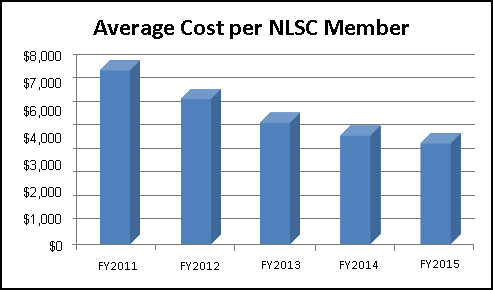
The NLSC is able to lower its average investment per Member as the number of Members increases relative to the support base and the investment per Member is amortized over a larger denominator.
The deployment of Members in support of service for the security and welfare of the nation is the purpose for NLSC and the budget CONOPS supports this purpose, including determining and illustrating these deployments. Figure 3.2.9.2-7 illustrates the activation for 20% of NLSC Members over the initial five year budget period.
Figure 3.2.9.2-7: Annual Activation
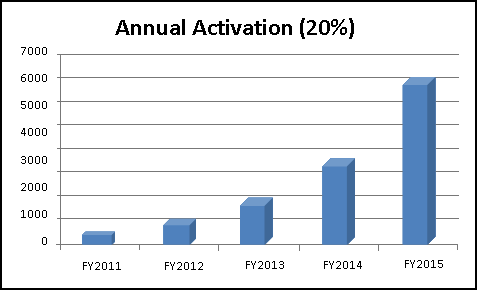
The programmed NLSC activations are 400 Members in FY 2011, 800 Members in FY 2012, 1,600 Members, FY 2013, 3,200 Members in FY 2014, and 6,400 Members in FY 2015. Fifty percent of these activations are assumed not to include deployment and 50% are assumed to include deployment with the NLSC paying the travel investments of its Members to and from the agreed departure site of the Member and the site of service. User organizations are assumed to pay round-trip travel to and from sites of service located overseas. The CONOPS for a five year activation budget is illustrated in Figure 3.2.9.2-8.
Figure 3.2.9.2-8: Activation Budget
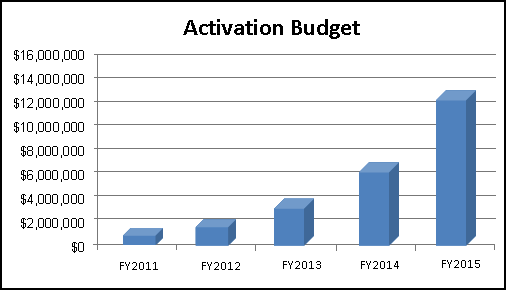
The ability to deliver a favorable ratio “tooth-to-tail” is an important factor that must be visible, defendable, and continuously demonstrated to supporters and critics alike for NLSC success. The CONOPS for realizing these requirements is illustrated as direct and indirect investments in the following graphics Figure 3.2.9.2-9 through Figure 3.2.9-12.
Figure 3.2.9.2-9: Direct Costs
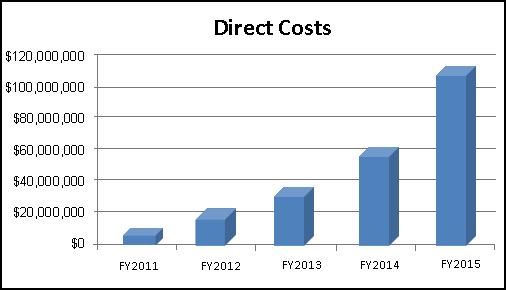
Direct investments, which represent the teeth of the NLSC, are those that can be directly related to accomplishing the NLSC mission for providing and maintaining a readily available civilian corps of certified expertise in languages determined to be important to the security and welfare of the nation. Examples of budget line items included in direct investments include Member NACs; Member Readiness; Language Proficiency Training; Certification; Operations including Member Activation, Deployment, Redeployment, Pay, and Operations of the 24/7 Communications and Data Management Center as well as Liaison and Agreements with User organizations.
Figure 3.2.9.2-10 is an example of the CONOPS for illustrating the distribution of the NLSC budget by major functional areas of User agreements and Liaison, Operations, and Personnel.
Figure 3.2.9.2-10: Direct Investments
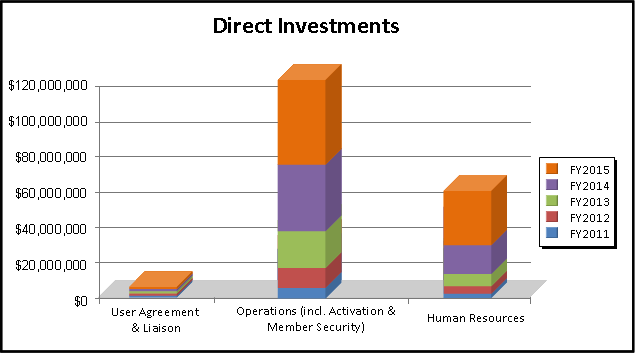
The NLSC indirect investments represent the NLSC tail and include budget lines items related to management, staffing including Special Staff, Plans and Policy, Supplies and Services, and Security (Figure 3.2.9.2-11).
Figure 3.2.9.2-11: Indirect Investments
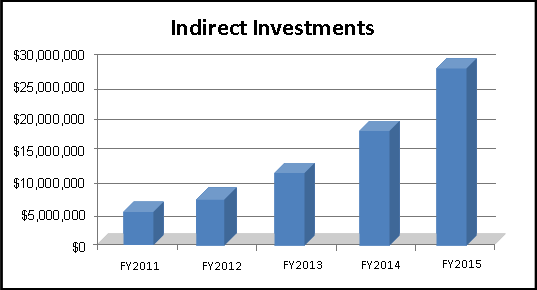
The following graphic Figure 3.2.9.2-12 is an example of the CONOPS for illustrating the distribution of the NLSC budget by major functional areas of Special Staff, Plans and Policy, Supply and Services, and Security.
Figure 3.2.9.2-12: Indirect Investments
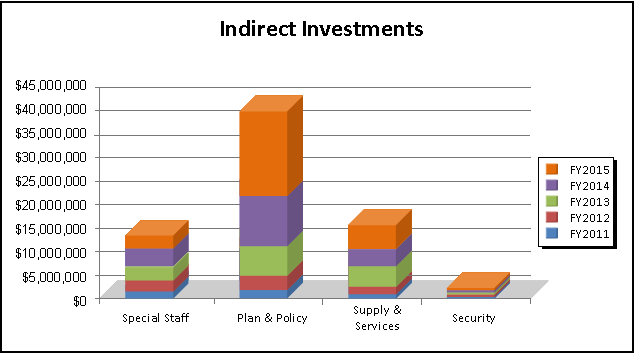
The budget CONOPS includes annually determining and comparing NLSC direct and indirect investments to provide visibility of the relationships for ensuring that a favorable “tooth to tail” ratio is established and maintained over time. The following graphic (Figure 3.2.9.2-13) illustrates the CONOPS for comparing NLSC direct and indirect investments.
Figure 3.2.9.2-13: Percent of Total NLSC Budget
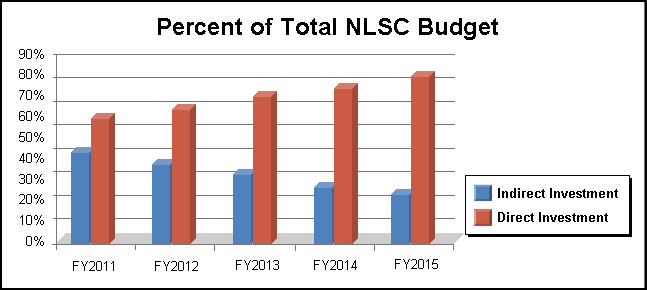
The goal is to reduce indirect investments while increasing direct applications of funds to direct mission support over time. The initial NLSC five year budget provides for the larger upfront indirect support investments required for establishing and getting the organization fully operational in FY 2011. This initial year is followed by a steady annual decline of indirect investments and an increase of funding for direct, mission-related requirements.
The NLSC CONOPS also provides for calculating and providing visibility of the budget by major functions such as illustrated below (Figure 3.2.9.2-14) for operations. This visibility provides information for comparing investments and investments by functional areas and making trade-offs where required.
Figure 3.2.9.2-14: Operations

The above graphic illustrates the allocation of NLSC funding for line items included in the major function of operations for each fiscal year. The graphic below (Figure 3.2.9.2-15) illustrates the same information for the major function of human resources.
Figure 3.2.9.2-15: Human Resources
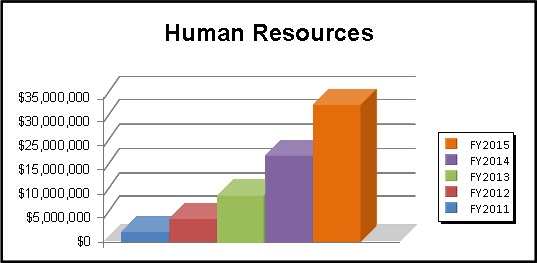
The CONOPS also includes budget calculations as a percent of direct and indirect investments by major categories or line items for each fiscal year. The following graphic (Figure 3.2.9.2-16) illustrates FY 2014 direct investments as a percent of the NLSC budget.
Figure 3.2.9.2-16: Percent of FY2014 Direct Investment Total by Major Function

The CONOPS includes similar data calculations and presentations for indirect investments such as illustrated below (Figure 3.2.9.2-17). The graphic for Plans and Policy illustrates the increased staff and number of activities such as User Agreements & Liaison, Lessons Learned, Requirements, and Programming & Budget required to support the number of NLSC Members that has grown from 1,000 to 32,000 over the five year period of FY 2010 to FY 2014.
Figure 3.2.9.2-17: Plans & Policy
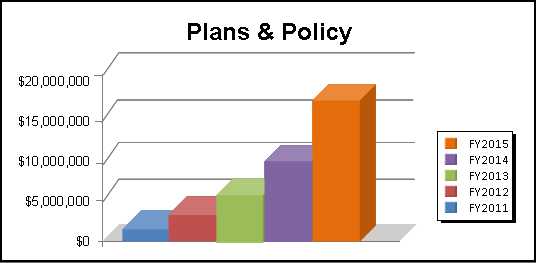
The CONOPS also provides for increases in investments required for other indirect functions as the NLSC increases in size and its activities expand in areas such as supplies and services and security illustrated below (Figure 3.2.9.2-18 and Figure 3.2.9.2-19).
Figure 3.2.9.2-18: Supply & Services
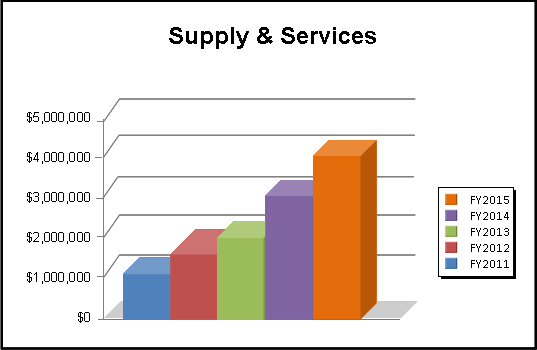
It is reasonable for NLSC investments for supply and services to swell with an increase in Membership, deployments, and redeployments. For example, NLSC facilities will need to be expanded to support increased operational capacity and the IT infrastructure, which includes equipment, software, and technical support, will necessarily be augmented to support additional staff and Member activities.
In a similar manner, the investment in security increases as additional NLSC candidates are recruited and are administered background checks and the number of corresponding security related files grow. Staff will require security clearances and the general operational, information, and physical security of NLSC organizational and operational activities will need to be ensured.
Figure 3.2.9.2-19: Security
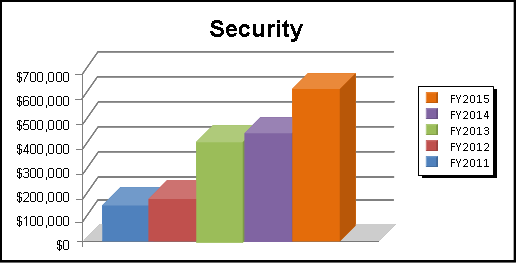
These presentations of data provide additional tools for allocating and tracking NLSC investments, the returns on investment and tooth-to-tail ratios. The NLSC challenge is to manage the allocation and expenditure of funds to ensure the organization provides a favorable return on investment. It also must clearly and quickly demonstrate this favorable return to supporters and critics with data. The template for the NLSC PPBE CONOPS is a series of Excel spreadsheets with data that are linked between sheets and with presentations of these data in various graphical formats. These data presentations are consistent with and reflect many of the metrics being used for measuring and reporting NLSC PPBE issues.
Table 3.2.9.2-19 defines the relationships and interactions with and in support of other NLSC functions and activities.
Table 3.2.9.2-19: Functional Relationships and Interactions
Function: Program, Plans, and Budget Execution (PPBE) |
|
Function/Activities |
Relationships/Interactions/Support |
Director
|
Comply with guidance from the Director/ Ensure relevant budget data is captured and disseminated to Congress/ Stay informed of pertinent legislative developments that could impact budget process. |
Deputy Director
|
Comply with guidance from the Deputy Director/ Reports activities in order to support the responsibilities of Finance & Accounting as well as the Inspector General/ Collaborates with Finance & Accounting to ensure financial congruency across all NLSC activities.
|
Marketing |
Provide feedback to ensure allocation of future resources. |
Operations
|
Development budget for all areas. |
Supply & Services
|
Ensure supplies and equipment are available and in working order to provide necessary support/ Make effective use of technology/ Ensure adequate space is available for Staff. |
Security
|
Provide security information and awareness briefs/ Conduct checks of work spaces to ensure compliance with security requirements/ Safeguard information in secure location. |
Human Resources
|
Contribute to the budget development process. |
Recruiting |
Interact with Marketing to provide feedback and ensure allocation of future resources. |
3.2.9.3Metrics
Table 3.2.9.3-1 defines metrics used to measure and report the effectiveness and efficiency of preparing the NLSC budget.
Table 3.2.9.3-1: Metrics Definition
NLSC PPBE Metrics |
|
Description: The NLSC PPBE is the process for preparing, monitoring, measuring, adapting, and reporting the organization’s current and five year budget. |
|
Goal: A flexible and repeatable process for preparing, monitoring, measuring, adapting and reporting the current and five year budgets that enables the NLSC to provide and maintain a readily available civilian corps of certified expertise in languages determined to be important to the security and welfare of the nation. |
|
Metric: Budget planning preparation is aligned with the organization goal and satisfies the Program Assessment Rating Tool (PART). |
|
Measure of Performance |
Data Elements |
Budget preparation and submission |
NLSC requirements
Budget prepared and submitted IAW established timelines
Budget accuracy: number of changes made by:
Budget supporting materials
|
Budget monitoring
|
Number of line items
|
Budget measuring
|
Total investment made
Number of line items
|
Budget flexibility
|
Changes made after submission
|
Budget reporting
|
Number of budget reports
Number of budget inquires
|
Repeatable budget process |
Number of budget line items repeated
|
4.0NLSC Organization
4.1Assumptions
The assumptions supporting the NLSC Organization CONOPS are provided below.
The NLSC is composed of the following functions: Office of the Director, Office of the Deputy Director, Plans and Policy, Operations, Human Resources, Marketing, Supply and Services, Security, and Recruiting.
The Director leads the NLSC and has a special staff composed of Quality Assurance and Accountability, Measuring, and Reporting (AM&R); General Counsel; and Legislative Affairs.
The Deputy Director directly oversees the Inspector General, Public Affairs, Equal Opportunity, Medical Counsel, and Finance and Accounting and supervises Plans and Policy, Operations, and Human Resources as the primary functions.
Plans and Policy is composed of User Agreements and Liaison, Lessons Learned, Requirements, and Programming and Budget.
Operations is composed of the Operations Center, Member Readiness, Certification, Language Proficiency Training, and the 24/7 Communications and Data Management Center (CDMC).
Human Resources is composed of Member Agreements, Pay and Benefits, and Human Resources Support.
Marketing is a sub-function of Plans and Policy.
Supply and Services is a sub-function of Operations and consists of Facilities, Transportation, Supply, IT Infrastructure, and Procurement and Contracting.
Security is a sub-function of Operations and includes Information, Physical, and Operations Security; Staff Clearances; and Member National Agency Checks (NACs).
Recruiting is a sub-function of Human Resources.
4.2CONOPS
The NLSC will be headed by the Office of the Director which will oversee the Deputy Director’s Office and the Corps’ seven functions and sub-functions. Figure 4.2-1 outlines the general organizational structure of the NLSC.
Figure 4.2-1: Functional Responsibilities

The Office of the Director includes the Director; Quality Assurance and Accountability, Measuring, & Reporting (AM&R); General Counsel; and Legislative Affairs.
The Director is responsible for overseeing the design and implementation of the NLSC according to Federal directive.
Quality Assurance and AM&R performs on-site monitoring and measuring in order to ensure the maximization of the NLSC’s available resources and potential. It investigates, analyzes, and reports on quality, accuracy, efficiency, and effectiveness in the NLSC’s administrative and operational capacities. Quality Assurance and AM&R will ensure that the NLSC’s processes, procedures, and operations conform to their specified requirements and adhere to their established directives.
The General Counsel acts as the primary legal advisor to the NLSC and ensures consistency in the interpretation and application of NLSC policies and procedures. The General Counsel's responsibilities include assisting in the development and implementation of new policies and procedures, interpretation of applicable statutes, promulgation of administrative rules and regulations, and representation before certain administrative and judicial bodies.
Legislative Affairs provides thorough and objective analyses of state and federal legislation with potential direct or indirect impacts on the NLSC. The Legislative Affairs Office also facilitates communication between the NLSC and Congress.
The Office of the Deputy Director includes the Deputy Director, Public Affairs, the Inspector General, Equal Opportunity, Medical Counsel, and Finance and Accounting.
The Deputy Director is charged with the implementation of the responsibilities of the Director relative to the administrative and operational policies and procedures of the NLSC. The Deputy Director shares responsibility with the Director for overall program development, program evaluation, policy formulation, and the direction and coordination of all NLSC activities. In addition, the Deputy Director is responsible for the day-to-day operations of the NLSC and, in the absence of the Director, assumes full responsibility for all functions performed by the NLSC.
Public Affairs informs, educates, coordinates, and communicates with the media and targeted audiences to achieve understanding, acceptance, and support for the NLSC. The Public Affairs office develops and implements public affairs strategies to achieve NLSC program objectives in coordination with other NLSC components. It coordinates news media relations strategy; responds to all media inquiries concerning NLSC operations and related issues; develops fact sheets, news releases, and other publications on NLSC programs and initiatives; and manages preparation and clearance of speeches, official statements, and other publications regarding NLSC activities.
The Inspector General is responsible for detecting and preventing fraud, waste, abuse, and violations of the law; promoting economy, efficiency, and effectiveness in the programs and activities of the NLSC; and providing a means for keeping the NLSC Director and Congress fully and currently informed about problems and deficiencies and the necessity for and progress of corrective action. The Inspector General fulfills these responsibilities by conducting audits, internal investigations, inspections, and other reviews.
The Equal Opportunity Office ensures the provision of equal opportunity for all employees and applicants on the basis of merit and without regard to race, color, religion, sex, age, national origin, sexual orientation, and physical or mental disability. It ensures that all administrative and operational decisions and personnel actions, including recruitment, accession, training, and benefits are administered in conformance with Federal statutes and regulations governing equal employment and personnel management.
The Medical Counsel acts as the primary medical advisor to the NLSC and ensures best medical practices in the interpretation and application of NLSC policies and procedures. The Medical Counsel's responsibilities include assisting in the development and implementation of new policies and procedures, interpretation of applicable statutes, and representation before certain administrative and judicial bodies.
Finance and Accounting serves as the focal point for the NLSC’s financial matters by providing direction, planning, and oversight for financial policy and procedures, financial reporting, the management control program, accounting policy and systems, and audit follow-up.
The Plans and Policy Office reports to the Office of the Deputy Director and includes User Agreements and Liaison, Lessons Learned, Requirements, and Programming and Budget.
User Agreements and Liaison conducts User interface and marketing to promote NLSC visibility and establish and maintain relationships with User organizations at the local, state, and federal level. The User Agreements and Liaison Office establishes and maintains Memoranda of Agreement between the NLSC and various User agencies.
Lessons Learned facilitates the sharing of information in a consistent and timely manner among NLSC functions and analyzes experiences throughout management and across functional areas in order to formulate recommendations to potentially reduce risk, improve efficiency, and enhance the cost effectiveness of NLSC processes and operations. Lessons Learned will provide information and analyses for continuous improvement in defining and planning NLSC policy and procedures.
Requirements analyzes and translates national security and domestic needs into operational language requirements, determines the existence of language capabilities and/or gaps for fulfilling these operational requirements, and seeks to fill any resulting gaps. Requirements support U.S. government interagency activities for developing current as well as future requirements determination.
Programming and Budget is responsible for the form, content, and timelines for budget development, pay plan, and submission to Congress, as well as management of NLSC operating budgets and budget reductions. The mission of the Programming and Budget Office is to improve, direct, and oversee the budget development processes; evaluate and analyze budget proposals; recommend alternatives; and to prepare, distribute, present, and advocate budget recommendations.
Operations reports directly to the Office of the Deputy Director and includes the Operations Center, Member Readiness, Certification, Language Proficiency Training, and the 24/7 Communications and Data Management Center (CDMC).
The Operations Center works closely with Human Resources and is responsible for tracking and supporting all activated and deployed NLSC Members. As the primary point of contact, the Operations Center ensures that activated and deployed Members are fully equipped and fulfill User expectations and, when deployed, arrive at the User requested site and are successfully redeployed upon completion of their service.
Member Readiness is responsible for conducting and monitoring User culture training, operational training, and ensures deployment preparedness for activated Members in lieu of User requests and declared missions.
Certification is responsible for ascertaining the foreign and English language skills of new Members, recertifying existing Members, and maintaining records of available tests by language.
Language Proficiency Training serves to sustain language proficiency for existing NLSC Members by providing them with materials, dialogue, and exchange (see Table 4.2-2).
Table 4.2-2: NLSC Training Delivered and information provided
Subject Area |
User Community |
NLSC |
National Pool |
Dedicated Pool |
|
|
|
Staff |
Recruiters |
|
|
Language Skills |
nlsc |
nlsc |
nlsc |
nlsc |
nlsc |
Cultural Skills |
nlsc |
nlsc |
nlsc |
nlsc |
nlsc |
Certification |
nlsc |
nlsc |
nlsc |
nlsc |
nlsc |
Job Skills |
|
NLSC |
nlsc |
nlsc |
Dedicated Sponsor |
Member Readiness |
nlsc |
nlsc |
nlsc |
NLSC |
NLSC |
Art of using Language Skills |
|
|
|
|
|
Interpreter |
nlsc |
nlsc |
|
nlsc |
nlsc |
Translator |
nlsc |
nlsc |
|
nlsc |
nlsc |
Instructor |
nlsc |
nlsc |
|
nlsc |
nlsc |
Career Development |
|
|
|
|
|
NLSC functions & processes |
nlsc |
NLSC |
NLSC |
nlsc |
nlsc |
Other Foreign Languages |
nlsc |
nlsc |
nlsc |
nlsc |
nlsc |
The 24/7 Communications and Data Management Center (CDMC) supports the NLSC staff performing program management, human resources management, financial management, and technical support for the day-to-day administration of the NLSC (see Figure 4.2-3). It includes the databases necessary for supporting the performance of requirements, plans and policy, operations, budget, human resources, training, supply and services, marketing, recruiting, and public affairs as well as materials for education, training, and information. The capabilities of the CDMC also support collaboration among its users with a common data library and management system and synchronous collaborative system.
Figure 4.2-3: 24/7 CDMC
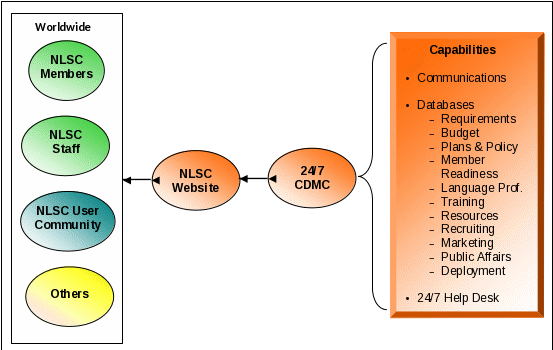
Human Resources reports directly to the Office of the Deputy Director and includes Member Agreements, Pay and Benefits, and Human Resources Support.
Member Agreements is responsible for populating and sustaining the NLSC Member database to include processing Member applications, establishing and updating memoranda of agreement between the NLSC and Members, and activating NLSC Members upon approval of User requests and deactivating Members upon completion of the mission.
Pay and Benefits maintains information regarding NLSC staff and Member salaries and benefits.
Human Resources Support is responsible for maintenance of Member personnel records, the assembly and delivery of deployment packages.
Marketing reports directly to Plans and Policy and works closely with Plans and Policy to determine objectives; develop strategic messaging, marketing materials, and media relations; and construct a strategic bridge between potential Members and the NLSC.
Supply and Services reports directly to Operations and is responsible for NLSC facilities to include the physical headquarters of the NLSC as well as remote recruitment centers and enrollment and training sites; submitting, processing, and managing procurement orders and contracts; acquiring and sustaining inventory to include expendable supplies and equipment; providing technical support to existing Members and staff and supplying all IT equipment and software for operations; and arranging and supporting all staff and non-deployment related travel for purposes of recruiting, training, and other NLSC activities (see Figure 4.2-4).
Figure 4.2-4: Supply & Services
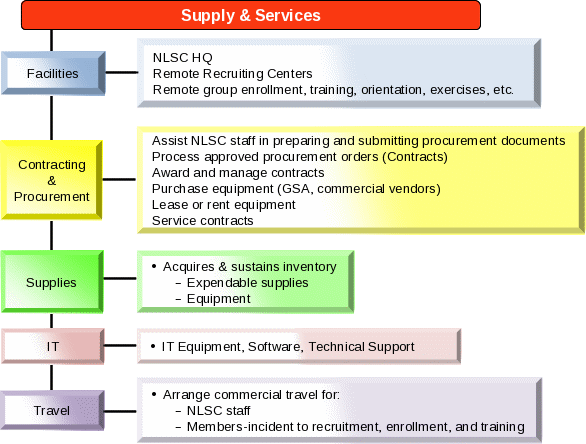
Security reports directly to Operations and is responsible for operational, information, and physical security as well as national agency checks (NACs) for Members and NLSC staff clearances.
Recruiting reports directly to Human Resources and is responsible for hiring and training recruiters; defining targets in order to meet recruiting quotas; developing recruiting materials; and conducting community outreach to augment leads and achieve specific target quotas.
Staff
In order to achieve operational success, the NLSC will require a number of dedicated staff. Table 4.2-5 and Figure 4.2-6 outline the required dedicated staff per operational year.
Table 4.2-5: NLSC Dedicated Staff
|
FY 2011 |
FY 2012 |
FY 2013 |
FY 2014 |
FY 2015 |
|
Office of the Director |
Director |
1 |
1 |
1 |
1 |
1 |
|
Quality Assurance, AM&R |
1 |
1 |
1 |
1 |
1 |
|
General Counsel |
1 |
1 |
1 |
1 |
1 |
|
Legislative Affairs |
1 |
1 |
1 |
1 |
1 |
Office of the Deputy Director |
Deputy Director |
1 |
1 |
1 |
1 |
1 |
|
Public Affairs |
1 |
2 |
2 |
3 |
3 |
|
Inspector General |
1 |
1 |
1 |
1 |
1 |
|
Equal Opportunity |
1 |
1 |
1 |
1 |
1 |
|
Medical Counsel |
1 |
1 |
1 |
1 |
1 |
|
Finance & Accounting |
2 |
4 |
5 |
6 |
6 |
Plans & Policy |
User Agreements & Liaison |
3 |
4 |
4 |
4 |
4 |
|
Lessons Learned |
1 |
1 |
1 |
2 |
2 |
|
Requirements |
2 |
3 |
4 |
5 |
6 |
|
Programming & Budget |
2 |
4 |
5 |
6 |
6 |
Operations |
Operations Center |
2 |
3 |
3 |
4 |
5 |
|
Member Readiness |
2 |
3 |
4 |
5 |
6 |
|
Certification |
1 |
1 |
2 |
3 |
3 |
|
Language Proficiency Training |
1 |
1 |
2 |
2 |
2 |
|
24/7 CDMC |
11 |
14 |
17 |
17 |
17 |
Human Resources |
Member Agreements |
2 |
3 |
3 |
4 |
5 |
|
Pay & Benefits |
2 |
3 |
3 |
4 |
5 |
|
HR Support |
3 |
4 |
6 |
8 |
10 |
Marketing |
|
2 |
3 |
3 |
3 |
3 |
Supply & Services |
|
1 |
1 |
1 |
2 |
2 |
Security |
|
1 |
1 |
2 |
2 |
3 |
Recruiting |
|
- |
- |
- |
- |
- |
Figure 4.2-6: NLSC Staff
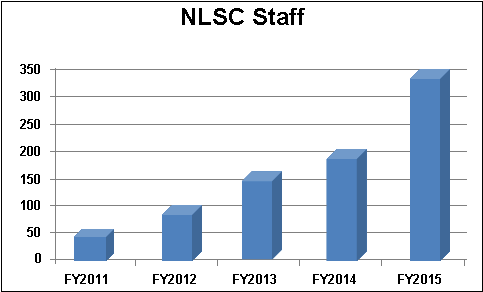
The exact number, nature, and distribution of these staff will be tested and evaluated during the Prototype. The drive for the staff will be the demand for NLSC service and the size of the Corps.
At the same time, however, while staff numbers rise, NLSC Member numbers increase exponentially. It is expected that the ratio of staff to members will shrink as the Corps matures. Figure 4.2-7 illustrates the Member per Staff ratio by operating year.
Figure 4.2-7: Membership per Staff
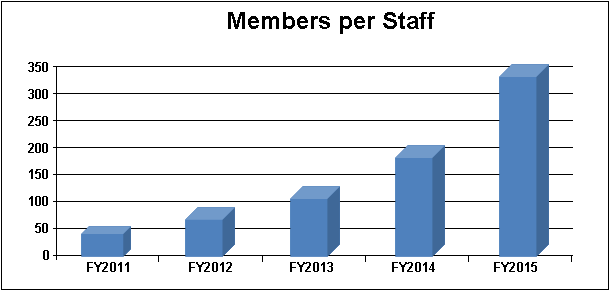
4.3Metrics
See Table 4.3-1 for the metrics used to gauge efficiency effectiveness, and economy.
Table 4.3-1: Metrics Definition
NLSC Organization Metrics |
|
Description: The NLSC Organization is the overarching structure by which the NLSC functions and performs in its day-to-day administrative and operational capacities. |
|
Goal: An efficient, effective, and economical organizational structure that enables the NLSC to provide and maintain a readily available civilian corps of certified expertise in languages determined to be important to the security and welfare of the nation. |
|
Metric: Recurrent monitoring, measuring, and reporting of the NLSC organizational structure. |
|
Measure of Performance |
Data Elements |
Efficiency |
|
Effectiveness
|
|
Economy
|
|
5.0CONOPS Testing and Evaluation
The GDIT Team will further develop and mature the CONOPS during a series of scenario-driven staff exercises during the first six months of Option Year 1. We will then use three activation exercises as the primary vehicles for testing and evaluating the integrated CONOPS: one conducted during the second half of Option Year 1 and two conducted during Option Year 2. These activation exercises provide opportunities to explore, test, validate, and provide feedback for adapting the CONOPS and business practices under circumstances and environments that approximate real-world conditions. The planning for these activations will be comprehensive to provide data for each measure of performance and each data element comprising the metrics for NLSC operations.
5.1Assumptions
The assumptions supporting the testing and evaluations of NLSC CONOPS are provided below.
NLSC Members have been recruited, certified, and enrolled
NLSC functions and subfunctions are fully operational
Requirements determination process is operational and User requirements have been identified
The marketing plan and recruiting plan is available
Language assessment and certification plan is available
Human Resources is operational
NLSC staff are trained and equipped for operations
The Operations Center is in place
The 24/7 Language and Communications Center and CDMC are available
Member Readiness procedures are available
Activation, Deployment, and Redeployment procedures are available
Federal partners have agreed to participate and are available
Metrics with measures of performance and data elements are available
Activation exercise scenarios are available
5.2Activation Exercise Scope and Phases
The scope establishes boundaries for these exercises and is summarized below in Table 5.2-1.
Table 5.2-1: Activation Exercise Scope
Scope |
Exercise 1 |
Exercise 2 |
Exercise 3 |
|
Number of NLSC Members participating |
||
|
100 |
100 |
100 |
|
50 |
50 |
50 |
|
5 |
5 |
5 |
|
100 |
100 |
100 |
|
|||
Participating partner |
Non-DoD |
DoD |
Non-DoD |
Exercise location |
CONUS |
CONUS & Overseas |
CONUS |
Scenario |
Emergency |
Non-Emergency |
Non-Emergency |
NLSC Liaison established |
Yes |
Yes |
Yes |
NLSC/User Cost Share
|
|||
Each activation exercise is completed in three phases: activities completed before activation; activities completed during activation; and post-activation activities. These phases and the major functions being tested and evaluated in each phase are summarized below in Table 5.2-2.
Table 5.2-2: Activation Exercise Phases
Scope |
Pre-Activation |
Activation |
Post-Activation |
Duration |
Up to 6 months |
5 working days |
Up to 2 months |
Requirements |
▲ |
|
|
Marketing |
▲ |
|
|
Recruiting |
▲ |
|
|
Assessment and Certification |
▲ |
|
|
Member Agreement |
▲ |
|
|
Member Readiness |
▲ |
|
|
Member service package |
▲ |
|
|
NLSC liaison established |
▲ |
|
|
Member serves IAW scenario |
|
▲ |
|
Member redeploys |
|
|
▲ |
Member completes post activation activities |
|
|
▲ |
Lessons learned |
|
|
▲ |
After action report |
|
|
▲ |
Phase 1 is essentially a continuation of the staff exercises conducted during the first half of Option Year 1 and includes pre-activation activities such as requirements, marketing and recruiting, assessment and certification of language proficiency levels, negotiating Member agreements, and Member readiness training. We anticipate testing and evaluating the full range of marketing means in five locations during Option Year 1 to support the operational requirements of the federal partner in Activation Exercise 1. These markets are expected to be expanded in Option Year 2 to support the operational requirements of federal partners participating in Activation Exercises 2 and 3. The testing and evaluation of recruiting in Option Year 1 measures and reports our success in securing no fewer than 1,000 NLSC Members in the languages identified in Deliverables 1, 2, and 3. The testing and evaluation plan also includes being able to enroll NLSC Members in response to requirements-based demands. The testing and evaluation for certifying language proficiency is to complete the assessment and/or certification for a minimum of 100 Members in the languages required to meet the operational requirements of the federal partners participating in Activation Exercises 1, 2, and 3. This plan includes designing and completing methodologies for comparing the results of assessments and certification to determine the feasibility and opportunities for using assessments as the basis for determining the language proficiency of Members supporting NLSC Users.
Phase 2 is the actual activation and potential deployment of NLSC Members (Charter Members) and is expected to take up to five working days. It is expected that up to 100 Charter Members may be alerted for possible activation and deployment; but no more than 50 Charter Members will be activated and no more than five will actually be deployed (physical movement) in support of User organizations. Phase 3 is the redeployment and post-activation activities. The five Charter Members will be redeployed. All of the 50 Charter Members activated, including the five deployed Charter Members, will participate in and complete post-activation activities. The 50 Charter Members of the 100 alerted for possible activation that were not activated are also included in post-exercise activities to obtain and analyze relevant data from their experiences.
An example of the template being used for designing the Activation Exercises is illustrated in Table 5.2-3. This matrix is prepared for each NLSC function performed and for each metric, each measure of performance and each data element, being used to measure and report progress. The Activation Exercise scenarios include events designed to generate data that can be collected and analyzed for each activity being tested and evaluated. The distribution of data collection, indicated by the “bullets” across the Activation Exercises, provides a visible means of ensuring events are prepared and introduced to generate data necessary for analyzing the performance of each measure of performance.
Table 5.2-3: Activation Exercise Design Template
Human Resources |
||||
Metric: NLSC provides efficient and effective Human Resources support for Members and Users |
||||
Measure of Performance |
Data Element |
Activation Exercise 1 |
Activation Exercise 2 |
Activation Exercise 3 |
Recruiting/Accessions Process |
Number of hits |
● |
● |
● |
|
Number of applications |
● |
● |
● |
|
Number of applicants accepted for membership |
● |
● |
● |
|
|
● |
|
● |
|
|
● |
|
● |
|
|
● |
● |
● |
|
Time from initial hit to application |
|
● |
● |
|
Time to load and analyze data |
|
|
● |
|
Time from hit to completion of NAC |
● |
|
|
|
Time from hit to certification |
● |
|
|
The GDIT Team will analyze data, assess findings, make recommendations, and brief the Government regarding each of the three exercises. We will also leverage these activation exercises as opportunities to evaluate marketing materials (video, scenario involvement) that support and amplify NLSC branding and marketing themes.
These activation exercises are designed across a spectrum ranging from simulation and live activities to exercise functions in a controlled environment designed for obtaining data and feedback to measure performance. The exercises are designed to accommodate the needs of participating partners. When possible, we will associate our activation exercises with planned exercises being conducted by these agencies. NLSC Members can expect activation processes and working environments for each of the three Government partners. Accordingly, a separate activation exercise plan is proposed for each customer base. Examples include:
The first activation exercise is with federal Users responding to an emergency environment within the context of the National Response Plan. It is anticipated that FEMA will be the lead federal agency being supported during the exercise. The positions of service being filled are located in the U.S. If possible, the activation will be part of a regularly-scheduled national exercise being conducted by the supported agency(ies).
The second activation exercise is with the DoD and will use Charter Members to exercise activation and deployment of Members to locations outside the United States. This exercise will include NLSC operations under normal conditions.
The third activation exercise is with a domestic partner operating within the United States in a non-emergency scenario outside the scope of the National Response Plan.
The activation exercises are designed to test and provide objective data for evaluating and adapting the CONOPS. They also provide data for legislative requirements, measuring key elements for verifying the activation, and providing metric-based results and recommendations for modifying the CONOPS. Examples of the variables the activation exercise design includes are: time to arrive at activation work station; activation difficulties encountered by Member; activation difficulties encountered by User; involvement in language and/or cultural activities of Members once on site; post-operational report from Member; post-operational report from User; and cost of activation. Each activation exercise is designed to evaluate: User satisfaction; Member satisfaction; special accomplishments; system failures; selected performance measures; recommendations for an Analysis of Alternatives (AoA) management tool; and modification or tailoring of marketing, branding, and recruiting.
5.3Planning for the Activation Exercise
The activities for planning exercises to test and evaluate the CONOPS include:
Kick-off meeting with key exercise participants at the proposed location of the activation exercise to verify the proposed location; review and further develop, as necessary, the activation exercise objectives, design, scenario, agenda, budget, and milestone schedule for organizing and conducting the exercise; and begin identifying activation exercise participants.
Forming Activation Exercise Design Team for designing and developing the activation exercise and determining and assigning the tasks that must be completed to prepare the activation exercise. This team will identify and validate issues for examination in fulfilling the objectives of the activation exercise. It also engages NLSC stakeholders to prepare a draft scenario. Selected representatives of these stakeholders receive this draft scenario seeking feedback. The team also conducts a validation exercise during the planning phase, identifying potential problems in design structure and execution planning to ensure the exercise is efficient and productive. The team walks through the components of the exercise and receives feedback on the workability of the exercise scenario and supporting events.
Design and develop the activation exercise with specifics of the exercise in a documented exercise plan that includes rules to guide the exercise execution and designs the exercise based on agenda objectives. The team discusses options and makes decisions about how to structure the exercise and assigns and manages activities of the participants during the exercise. The design includes a process for analyzing, documenting, and reporting information acquired from the exercise. The design undergoes an iterative review process to ensure the exercise meets the agreed objectives.
Prepare activation exercise documents after the exercise design is finalized to include complete versions of the activation exercise materials including Scenario; Master Scenario Event List (MSEL); Player Guides; and Seminar materials.
The activation exercise scenarios are developed in detail during Option Year One. The activation exercises are designed to validate the NLSC structure and verify that it can accommodate the requirements of the three main customer groups. The activation exercises will evaluate key critical elements and inputs both from NLSC Members activated and the exercise Users. Measures of effectiveness are developed and will likely vary somewhat from one activation exercise to another (User-dependent).
MSEL includes events that may be inserted into the scenario by an Activation Exercise Control Team. The Player Guide provides materials to participants to prepare for the activation exercise and exercise play including background information, the objectives and structure of the exercise, and materials used to execute the exercise. The seminar supporting materials provide background for a series of seminars conducted for NLSC Stakeholders. The seminar topics are recommended by the Exercise Planning Team for approval of the Contracting Officer's Technical Representative (COTR).
Conduct activation exercise validation to ensure the activation exercise design, scenario, and events can be executed to achieve the objectives. The rehearsal identifies areas to correct so the actual exercise is efficient and productive. The team conducts the activation exercise rehearsal, using the actual materials in the draft stage of development. The rehearsal is a face-to-face meeting during which participants walk through the activities of the activation exercise, including review of the materials. The Exercise Planning Team and a group of representative stakeholders participate in the rehearsal. Participants provide feedback with recommendations for changes prior to finalization of the activation exercise.
Adapt activation exercise scenario and events, based on data derived in the rehearsal, to finalize the materials, including schedules, to support an exercise that generates the required data.
Conduct advance preparation of activation exercise teams to provide advance preparation for the teams participating in the activation exercise. The Activation Exercise Design Team identifies and assigns members of each participating team. The teams are provided advance materials and a set of tasks designed to prepare them to participate in the activation exercise. GDIT will use the 24/7 CDMC with its Web-based communications portal for team members to interact for this task. The portal includes online document storage bins and communication tools such as Web-based forums and/or message boards.
5.4Conducting the Activation Exercises
The CONOPS includes three pilot activations described in Section 5.1 to exercise critical elements of the NLSC. These activation exercises are simulation activities designed to test and validate the CONOPS for a fully operational NLSC. Our expectations are that these activities will provide the data necessary for supporting the recommendations for the fully functioning organization.
The control organization for conducting the activation exercises includes: Higher authority consisting of NLSC stakeholders who observe the exercise and respond to inquires for information; the Exercise Control Team that manages the scenarios and events for conducting the exercise to ensure objectives are met and the necessary data are collected; the Exercise Data Collection Team that collects, records, and compiles the data generated during the exercise; the Exercise Human Resources Team to coordinate personnel issues that are outside the normal functional responsibilities of NLSC staff; the Exercise Liaison Team to coordinate exercise activities with NLSC stakeholder agencies and departments, including States when appropriate; the Exercise Logistical Team that plans and provides the logistical support required for conducting the exercise, to include post-exercise support; and the Exercise Administrative Team to provide support for the administrative issues involved in conducting the exercise. The GDIT Team will also work with NSEP for planning and coordinating media coverage. The following activities are completed during the conduction of these exercises:
Conduct activation exercise: The activation exercise is conducted to provide data for analyses to meet the agreed upon objectives. GDIT is responsible for exercise administration and logistics.
Conduct post-activation exercise analyses: The Analysis and Reporting Team performs this task by analyzing the data generated during the activation exercise to develop strategies and provide recommendations for a fully operational NLSC, including activation of Members. The analysis begins even as the activation exercise is progressing, as participants collect and summarize key points and recommendations. At the close of the exercise, the team produces a Quick-Look Report on the activation exercise and reports initial observations while the activities are still fresh on the minds of the participants and organizers.
The Exercise Design Team and the Exercise Control Team contributes to the analysis of the data. The data are presented as observations, challenges, and recommendations. These items are presented in the Post-Exercise Report, Post-Exercise Analysis, and Post-Exercise Summary.
Player Guide: The Player Guide provides materials for participants to prepare for the exercise and for exercise play. The guide includes the simulated scenario used during the exercise. It introduces participants to the activation exercise and its purpose, provides background information, and presents the activation exercise scenario and assumptions for the players.
Simulation Direction and Control Manual: This manual includes the scenarios and events for the activation exercise activities. It will guide the players through the activation exercise. The manual includes administrative materials and outlines for exercised events. It also identifies the facilitators, players, functions, tasks, and items for discussion associated with each move. This manual will ensure logical, timely, and productive movement through the exercise.
Hot Wash Briefings: Participants present briefings during or at the end of the exercise.
Quick-Look Report: The Quick-Look Report is provided to the Activation Exercise Director within 10 working days from the end of the exercise. It summarizes the activities of the activation exercise, includes initial observations, and recommends next steps at a general, executive level of detail. This report is created shortly after the conclusion of the activation exercise to quickly put observations, key points, and recommendations into writing.
Post-Exercise Report: This document reports the activities of the activation exercise, with some observations and recommendations. The report describes the activation exercise and reports the main features of the response to the scenarios and events introduced into the exercise. The report summarizes the activities and discussions associated with moves in the activation exercise. The report also includes a participant roster and any reports and presentations created by the teams during the activation exercise.
Post-Exercise Analysis: This document provides analysis of the key points brought to light during the activation exercise, supporting recommendations for post-activation exercise action.
Post-Exercise Summary: The Post-Exercise Summary is a briefing describing the event and summarizing observations, conclusions, and recommendations. This briefing provides stake-holders an understanding of the lessons learned and recommendations for action. The briefing is provided electronically and in hard copy, full-sized slides.
5.5Metrics
Refer to Table 5.5-1 for the metrics used for the Activation Exercises.
Table 5.5-1: Metrics Definition
Activation Exercises |
|
Description: Plans for activation are comprehensive including all aspects of activation from identification of “emergency issue,” search for Members from both Dedicated and National Pools, contact of Members, call-up, movement of personnel, compensation, and after action reports. |
|
Goal: Conduct activation exercises that enable the testing and evaluation of NLSC functions. |
|
Metric: Successfully Activate, Deploy, and Redeploy all required Members and satisfy all User requirements to 100%. |
|
Measure of Performance |
Data Elements |
NLSC Member participation
|
Number of Members alerted Number of Members activated Number of Members
|
Post-Activation |
Number of post-Activation activities
|
Participating partners
|
Exercise 1: Non-DoD Exercise 2: DoD Exercise 3: Non-DoD |
Locations
|
Exercise 1: CONUS Exercise 2: OCONUS Exercise 3: CONUS |
Scenario |
Exercise 1: Emergency Exercise 2: Non-Emergency Exercise 3: Non-Emergency |
NLSC liaison established |
Number of participating agencies Number of liaison:
|
NLSC functions
|
Number of NLSC functions
|
Metrics by NLSC functions
|
Number of metrics by NLSC functions
|
NLSC organization |
Number of organizational components
|
Data elements |
Number of data elements
|
Exercise planning |
Kick off meeting completed Activation Exercise Design Team formed Activation exercise design completed and developed Exercise documents prepared
Activation exercise validation event completed Activation exercise scenario and events adapted Advance preparation of exercise teams completed 24/7 CDMC available to support exercise |
Conduction of the Exercise |
Higher Authority participation Exercise Control Team manages scenarios and events Exercise Data Collection Team collects, records and compiles data Exercise Human Resources Team coordinates personnel issues Exercise Liaison Teams coordinates exercise with stakeholders Exercise Logistics Team coordinates logistics Exercise Administrative Team provides administrative support |
Post Exercise analyses |
Exercise Analysis and Reporting Team analyses data and prepares:
|
Addendum – NLSC Lexicon
Term |
Definition |
Accession Plan |
The process associated with adding Members or Charter Members to the NLSC. |
ACTFL |
American Council on Teaching Foreign Languages offers oral proficiency testing in more than 65 languages and writing proficiency testing in 12 languages. |
Activation |
Order changing the work status of a Member from a “stand-by” unpaid status to a paid, “work required” status in the federal service from either the National or Dedicated Pools. |
AOA |
Analysis of Alternatives |
AOR |
Area of Responsibility |
Applicant |
Somebody who has formally applied for NLSC Membership but is not yet designated a Member or Charter Member. |
Boren Scholarship |
NSEP offers opportunities for U.S. undergraduate students to study in world regions critical to U.S. interests but generally underrepresented in study abroad. |
Capstone Exercises |
Performance-based activities designed to facilitate knowledge transfer, through a common framework and operational concept, to guide participant development. |
CDMC |
Communications and Data Management Center for the NLSC. The CDMC is an electronic and digital hub for performing NLSC functions and responsibilities. |
Charter Members |
First volunteers to join the NLSC as a beta test group during the Pilot Project. These are not full Members of the NLSC. |
CONOPS |
Concept of Operations, designed to give an overall picture of the operation. |
CONUS |
Continental United States |
COTS technologies |
Commercial off-the-shelf technologies |
CPMS |
Civilian Personnel Management System - the personnel policy office of the DoD |
Deactivation |
Order to a stand-by, unpaid status in either the National or Dedicated Pools. |
Dedicated Sponsor |
A specific organization seeking a longer term agreement with an NLSC Member for use of their language and job-related skills. |
Deployment |
The relocation of Member(s) to desired operational areas. |
Director NLSC |
Chief Executive Officer for The National Language Service Corps |
DLI |
Defense Language Institute provides culturally based foreign language education, training, evaluation, and sustainment for DoD personnel. |
DLIFLC |
Defense Language Institute Foreign Language Center provides culturally based foreign language education, training, evaluation, and sustainment for DoD personnel. |
DLPT |
Defense Language Proficiency Tests, as developed by DLIFLC, currently encompass 55 languages and are widely used and recognized across the government language community. |
DLTR |
Defense Language Transformation Roadmap is the culmination of a two-year study which articulates the findings and the subsequent recommendations in determination of language capabilities necessary to support the National Defense Strategy. |
DOD |
Department of Defense |
EHLS |
English for Heritage Language Speakers helps professional-level native speakers of critical languages reach a similar level of proficiency in English. |
ETS |
Educational Testing Service designs, develops and implements customized assessment systems and support services tailored to meet the needs of clients and language test takers internationally. |
Employer |
Member's non-NLSC job employer. |
GOTS technologies |
Government off-the-shelf technologies |
ILR |
Interagency Language Roundtable is a numeric scale used to determine a speaker’s proficiency in reading, writing, listening, and speaking skills in a specified language. |
Language Certification |
Confirms language capability/proficiency level as specified |
Language Proficiency |
Skill level relating to a specific language |
LTI |
Language Testing International arranges ACTFL language proficiency assessments in 50+ languages for corporations, government agencies, academic institutions and individuals. |
Member |
Excepted Service Federal employee hired for his/her language skills for service at home and abroad in support of federal, state or local needs |
MOA |
Memorandum(s) of Agreement will be established between the NLSC and the User(s) on the utilization of, as well as the employment of, Members for validated operations. |
MOU |
Memorandum of Understanding |
NAC |
National Agency Check |
National Pool Member |
An approved NLSC applicant who meets the required minima for Membership and has agreed to join the organization. |
NFLP |
National Flagship Language Program. This program is sponsored by NSEP. |
NGO |
Non-governmental Organization |
NLSC |
National Language Service Corps is a conceptualized organization which will provide and maintain an available civilian contingent of certified volunteers in languages determined to be important to the security and welfare of the nation. |
NSEP |
National Security Education Program |
NSEPO |
National Security Education Program Office, as the lead Government office, will collaborate with Federal agencies and other interested stakeholders in identification of language skill requirements, as well as the number of linguists critical to each priority language. |
NSLI |
National Security Language Initiative was implemented in January, 2006, with the stated goal of enhancing linguistic capabilities throughout the departments of the Federal government and Members of society. |
OLA |
Office of Legislative Affairs |
OPI |
Oral Proficiency Interview. This is an oral examination used to test an individual’s ability to speak in a foreign language. |
OPLAN |
Operations Plan |
OPM |
Office of Personnel Management |
Orientation |
A meeting or series of events at which introductory information or training is provided to the NLSC staff, its Members, and using agencies. |
OSD |
Office of the Secretary of Defense |
Placement |
Position a Member fills when assigned to a specific User. |
PPBE |
Program, Plans, and Budget Execution is the system for resource allocation within the Department of Defense. |
Prospect |
An individual who may be interested in applying to the NLSC |
Prototype |
The original and contracted NLSC, which has the essential features and is the model that will test and evaluate the follow-on organization. |
Provisional Member |
Applicant who meets the
minima for |
Redeployment |
Relocating the Member(s) from the deployed location back to the original point of departure or to a new location. |
TOEFL |
Test of English as a Foreign Language is an examination designed to measure a non-native English speaker’s use and understanding of English as it is spoken, written, and heard in a collegiate setting. |
USERRA |
Uniformed Services Employment and Reemployment Rights Act. The NLSC will activate Members under this Act to protect their permanent place of original employment. |
User(s) |
User(s) can be defined as any local, state, or federal agency soliciting NLSC for Member utilization during normal operations, as well as during emergency/crisis operations. |
USG |
United States Government |
Volunteers |
Somebody who has offered to serve in the USG as a Member or Charter Member of the NLSC. |
| File Type | application/msword |
| File Title | THE NATIONAL LANGUAGE SERVICE CORPS |
| Author | Owner |
| Last Modified By | pltoppings |
| File Modified | 2008-02-15 |
| File Created | 2008-02-15 |
© 2025 OMB.report | Privacy Policy
